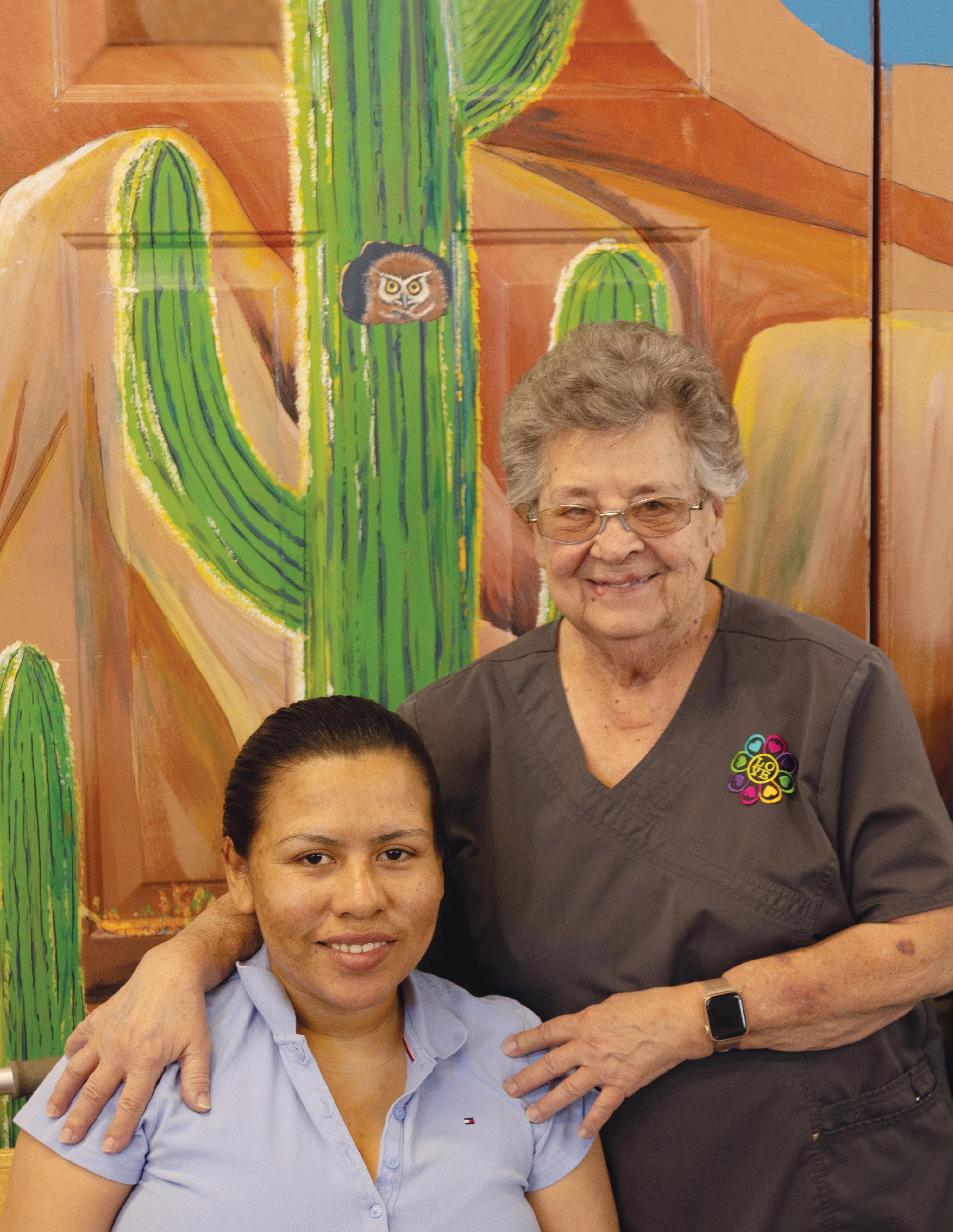
SIS TERS OF CHARITY OF CINCINNATI
Volume I, 2024
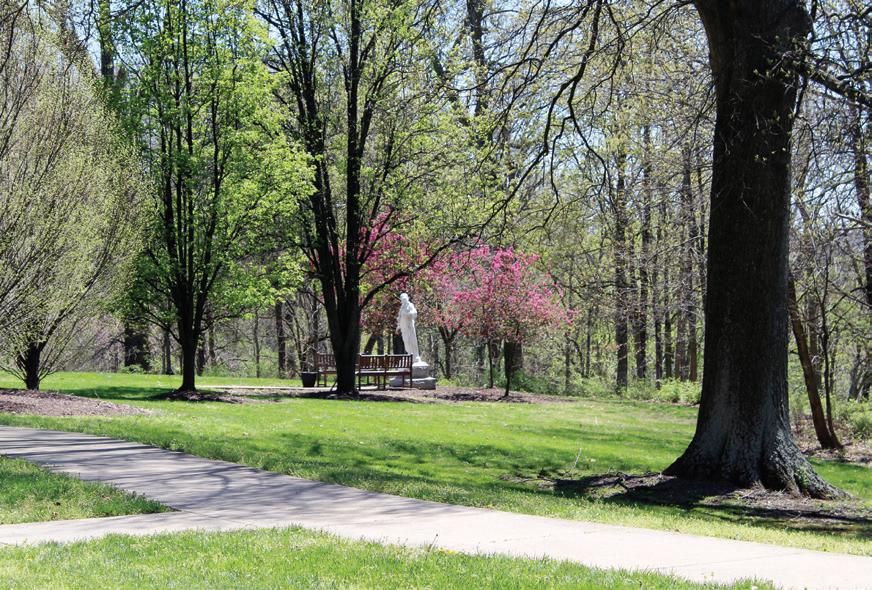
CONTENTS
FEATURES
Risking Hope 4-6
Women religious gather to look at current and emerging realities.
Children of the Shadows 8-9
Sisters of Charity ministering at the U.S.–Mexico border.
Building Bridges 10-11
Addressing the root causes of a broken immigration system.
Welcoming the Stranger 14-15
S. Nancy Crafton’s ministry to migrants in Colorado.
Experiencing God’s Love .......................... 16
Associate Angela Anno’s volunteer work at St. Leo in Cincinnati.
Answering a Call 17
Father Bill Morton’s tireless service to migrants at the border.
Countless Blessings 18-19
S. Patrice Vales celebrates 75 years as a Sister of Charity.
A Journey Into the Unknown ................... 22
S. Peggy Rein’s ministry at Holy Family School in Cincinnati.
Admirable Assistance 23
S. Pat Wittberg volunteers with Holy Family’s St. Vincent de Paul conference.
An Unexpected Journey 24-25
Associate Deborah Rose retires as executive director of FutureChurch.
Sharing Wisdom and Culture ................... 26
S. Alice Ann O’Neill attends the Suzuki Teacher Training Convention in Japan.
Drumming with Love 27
S. Shirley Le Blanc leads SC Drum Circle.
A Joyful Presence 28
S. Juliette Sabo’s influence at Romero Academy at Resurrection.
On the Cover: S. Nancy Crafton has dedicated more than 20 years of service and love to the migrants of Los Pobres Center in Avondale, Colorado. Cover photo by Brother Gary Sawyer, Associate.
Disclaimer: The information contained in Intercom is intended for general information and educational purposes only. Opinions expressed herein are the views of individual authors and do not necessarily reflect the opinions or policies of the Sisters of Charity of Cincinnati.
Dear Sisters, Associates and Friends,
The recent issue of The Occasional Papers, a publication of LCWR (Leadership Conference of Women Religious), caught my attention with the title on its cover, “Our Work is Loving the World.” Before I opened the cover to read the articles, I realized that this could be the title for this issue of Intercom As you peruse the pages you will read stories of hope, perseverance, joy and struggle through our Sisters’ and Associates’ lives and ministries. All of them share God’s message of love and faithfulness.

This Intercom focuses on the theme of immigration reflecting real life people’s stories who are addressing the issue from various perspectives. These are not statistics or generalizations we read about or hear on the news but these are stories of people who have come to this country seeking a better life and the struggles they face. We hear of ways Sisters, Associates and co-workers are ministering in outreach to immigrants and refugees to respond to their needs. Some of these efforts involve day-to-day ministries addressing basic needs. Others are involved in education and health-related systems that prevent people from living their best lives. Still others work on a systemic level to address legislation or lack of it that sets up barriers for changing laws that would help remedy unfair practices. Listen to the joy and struggle, perseverance and hope woven throughout these pages.
We also hear the stories of God’s love and faithfulness being present in places from Florida to Japan to Chicago to Rome to Cincinnati. Various people, a myriad of places and all telling of unique experiences reflecting on how “our work is loving the world.”
In this post-Easter season celebrating the Resurrection, we witness the many ways the people featured in this issue of Intercom witness to God’s faithfulness, bringing hope and love to our world.
May we join with them in being joyful signs of God’s love to those we meet in our daily lives.
Peace,
 Sister Barbara Hagedorn, SC
Sister Barbara Hagedorn, SC
IN MEMORIAM
Please visit “In Memoriam” at www.srcharitycinti.org for biographical information and reflections on the Sisters of Charity and Associates who have died. May our Sisters and Associates enjoy the fruits of their labor as well as peace with God.
S. Elizabeth ‘Betty’ Finn
March 25, 2024
S. Ann Koebel
March 16, 2024
Associate Pat Schloemer
March 13, 2024
S. Helen Berson
January 15, 2024
S. Juanita Marie Gonzales
December 29, 2023
S. Joseph Ellen Noppenberger
December 16, 2023
Associate Mary Jo Maximovich
November 14, 2023
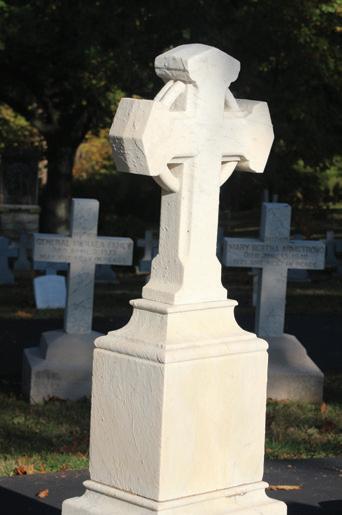
A L etter F rom o ur S i S ter in L e A der S hip
2 INTERCOM
Inspiring Action
By S. Monica Gundler
Gather. Pray. Celebrate. Serve. Embrace. Explore. Share. Create.
These words impel us into action. During Lent, the reflection book given to Sisters and Associates encouraged prayer with verbs, inviting action and echoing the language of the SC Horizon Statement, which guides the Community’s direction for the next four years. These words have manifested in myriad ways, shaping our gatherings, celebrations and engagements with the world.
The new year began as Sisters gathered in the silence of the Motherhouse chapel, gradually illuminated by the flickering glow of taper candles. Accompanied by joyful carols, S. Carol Zinn, SSJ, executive director of the Leadership Conference of Women Religious, was welcomed for a retreat celebrating the Epiphany and the Feast of St. Elizabeth Seton. This time challenged us with the image of the chrysalis to be awake and aware of the significant changes needed to continue our mission in a new age.
Our Justice Circles have equipped us with knowledge, spurred us to action and emboldened us to address the pressing needs of our time. In April the congregation joined with a number of regional Catholic religious congregations to sponsor a billboard message to end gun violence and promote peace. The message appeared near the Harrison Avenue Exit along Interstate 75 and read: “Put the Guns Down! Nobody is Winning. Let Peace Begin With Me.”
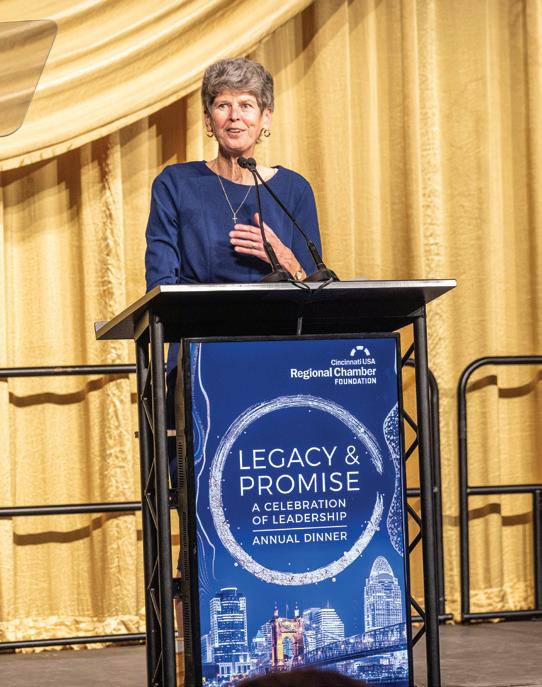

S. Sally said, “My hope and prayer is that this award represents the impact of the right relationships of the Sisters of Charity to our region.”
S. Barbara Hagedorn, councilor, explains, “When the idea of the billboard was proposed by S. Marcel DeJonckheere, it gave us a concrete way to respond and gave us our call to action. When the idea was mentioned to the other women’s communities in the area, we received great support. The billboard’s message is a collaborative plea for nonviolence and peace. We pray that the message has a positive effect on those who see it.”
In these days when it is sometimes hard to find inspiration in light of the news of the world, we continue to serve in faith and love. In February S. Sally Duffy was inducted into the Cincinnati Regional Chamber’s newest class of Great Living Cincinnatians. She was honored for her leadership, vision, tenacity and love of community. In her acceptance
Our Vocations Office continues to encourage young women with Wisdom Wednesdays and a vibrant social media presence. As later featured in this magazine, 13 Sisters participated in Hope-Esperanza, a gathering sponsored by the Leadership Collaborative, welcoming more than 200 Sisters under the age of 65. The gathering, which brought together Sisters from various corners of the world, reaffirmed our shared purpose: to be instruments of love, compassion and justice in a world yearning for healing and transformation.
We are grateful for the many lay partners and employees who enrich our journey with their commitment and collaboration. Employees have embraced the Sisters in mission with their engagement in holidays, celebrations, and much-needed donation drives. In March the Mother Margaret Hall Community Action Committee hosted a Spring Fling for Sisters and employees. The event included raffles, split-the-pot, games and more with all proceeds benefitting the clients of St. Vincent de Paul.
As we continue on our collective journey, let us remain steadfast in our commitment to gather, pray, celebrate, serve, embrace, explore, share and create, drawing strength and inspiration from each other and the world around us.
VOLUME I, 2024 3
Sisters of Charity employees, in collaboration with Mother Margaret Hall’s Community Action Committee, came together in March for a Spring Fling event to benefit the clients of St. Vincent de Paul.
In February 2024, S. Sally Duffy was inducted into the Cincinnati Regional Chamber’s newest class of Great Living Cincinnatians.
Risking Hope
How are we risking hope as we create bridges into our future? More than 250 women religious under the age of 65 gathered around this question at the Leadership Collaborative’s Hope-Esperanza gathering, Jan. 25-28, 2024. There were about 150 Sisters assembled in Chicago, Illinois, and nearly 100 on Zoom, representing 108 congregations and 26 different countries. Can you imagine the energy and creativity? The Leadership Collaborative wrote of Hope-Esperanza, the first gathering of its kind, “As we look at our current and emerging realities, it is vital for those of us who will be living this future to have conversations about how we want to create and live now and move into the future.”
Thanks to generous support from our Leadership Council, 13 Sisters of Charity of Cincinnati traveled to Chicago for the experience. Read some of their reflections below.
S. Alice Ann O’Neill
I was excited to be at the Hope-Esperanza gathering in Chicago because it has been years since we gathered together in person. Thirteen Sisters in our Community and many Sisters from our SC Federation attended. The topics and questions from the conference were presented in a variety of processes by panels of Sisters from many different charisms, cultures and communities:
Risking Hope
What are you willing to challenge and be challenged about in this life?
Can we be fearless? What does that mean? What would it look like?
Share an experience that you find yourself in your current ministry as an agent of hope and a co-creator with God.

Our Realities as Leaders Today
How am I being challenged and/or inspired by what I am hearing here? How is it informing my view of leadership?
Being Agents of Hope
What qualities do you think leaders need to try to develop that would be helpful for leading in this time of religious life?
If questions can be more transforming than answers, what kinds of questions do you think would be helpful for women religious or religious leaders to be raising these days among their members and with one another?
What is Emerging for Us as Leaders?
What does the Leadership Collaborative have to offer to the whole?
What do I need to be fully alive in religious life today?
What is calling me to engage and contribute to our current and emerging future?
What Do We Want to Create?
How are you willing to be disturbed in order to create something new?
What must you let go of to be “disturbed”?
How does the belief in worthiness play a central role in helping us develop a genuine connection with religious life today?
How does my belief in loving and belonging enable me to be a prophetic voice in my call as a leader?

In leadership, my willingness to be vulnerable is not a sign of weakness but an embrace of strength and authenticity.
How Do We Begin Creating Bridges?
As a leader, what are your core values? And how do they line up with your ministry that you are in today?
How do you create a sense of shared vision?
How can you bring together the gift and the grace of the individual and the
4 INTERCOM
Sisters Victoria Anyanwu (second from left), Sandy Howe (fourth from right) and Alice Ann O’Neill (third from right) with members of their Leadership Collaborative cohort.
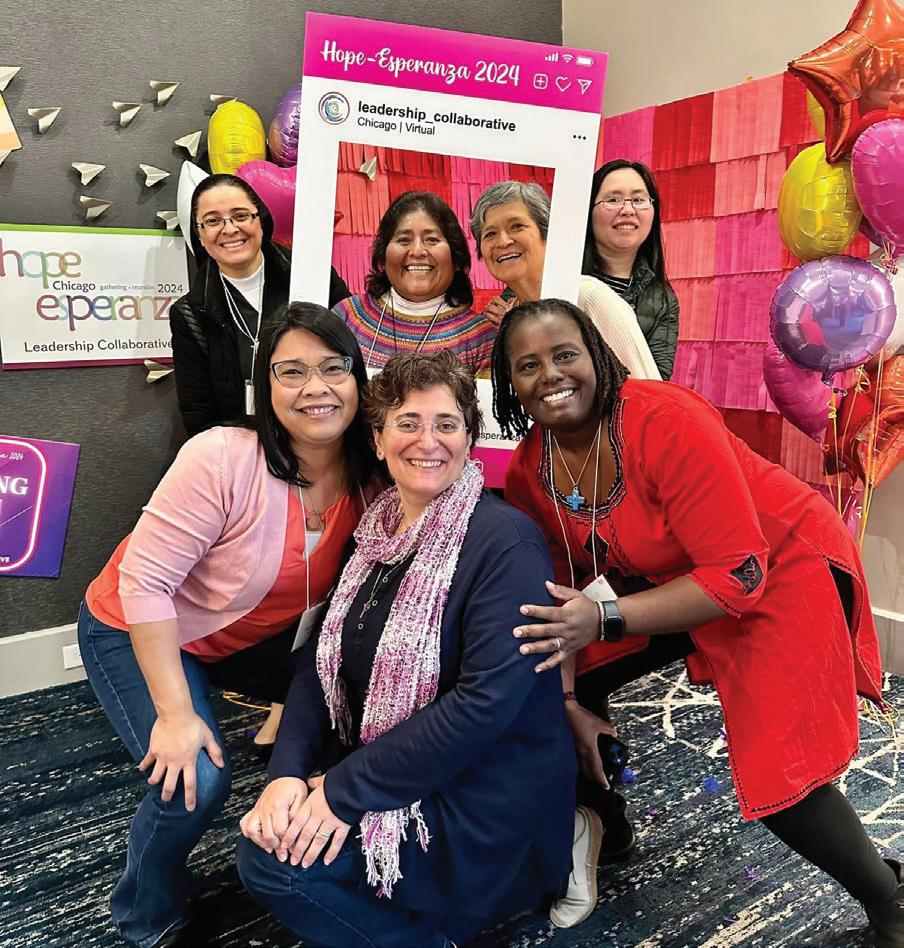

community to model a new reality for our world and our Church?
How do you see yourself being a bridge-builder for religious life?
There were lively discussions and sharing at tables and summaries of sharings at the microphones were presented visually. The large group discussions also included the nearly 100 Sisters on Zoom. Everything seemed to go smoothly with this hybrid online and in-person format as well with the Spanish translators. I enjoyed having meals and discussions with old and new friends, especially the many Sisters from South America and Africa.
S. Annie Klapheke
“Hope never disappoints, hope goes not alone, but together” (Pope Francis, papal audience, Sept. 22, 2021). This quote from Pope Francis captures the spirit that was present at the Hope-Esperanza gathering. As I looked around the room of 150-plus Sisters gathered from all over the world, what gave me hope for the future was knowing that we are in it together. As we face an uncertain future in religious life, our most important preparations will be to strengthen our relationships with one another. Throughout the weekend, as we talked, listened, laughed, prayed and held silence together, we found common ground and strengthened our bonds across congregations, cultures, languages and generations.
One word that stays with me from the experience is ubuntu, a traditional African concept that roughly means ‘I am because we are.’ S. Justine Naluggya, IHMR from Uganda, broke open this concept of ubuntu on a panel discussion about the realities of leadership. Ubuntu stresses the importance of interdependence, seeking the common good and recognizing that we deeply belong to one another. This is, of course, a core tenant of our faith; acknowledging that we are all members of the one mystical Body of Christ. We are incomplete without each other. What would it look like for women religious to fully embrace the spirit of ubuntu as we move into the future? How might our vocations flourish if we extend our identities and our hearts across congregations, cultures and generations? I imagine an everwidening circle, rich in diversity of charisms and culture. This is the future I hope for.
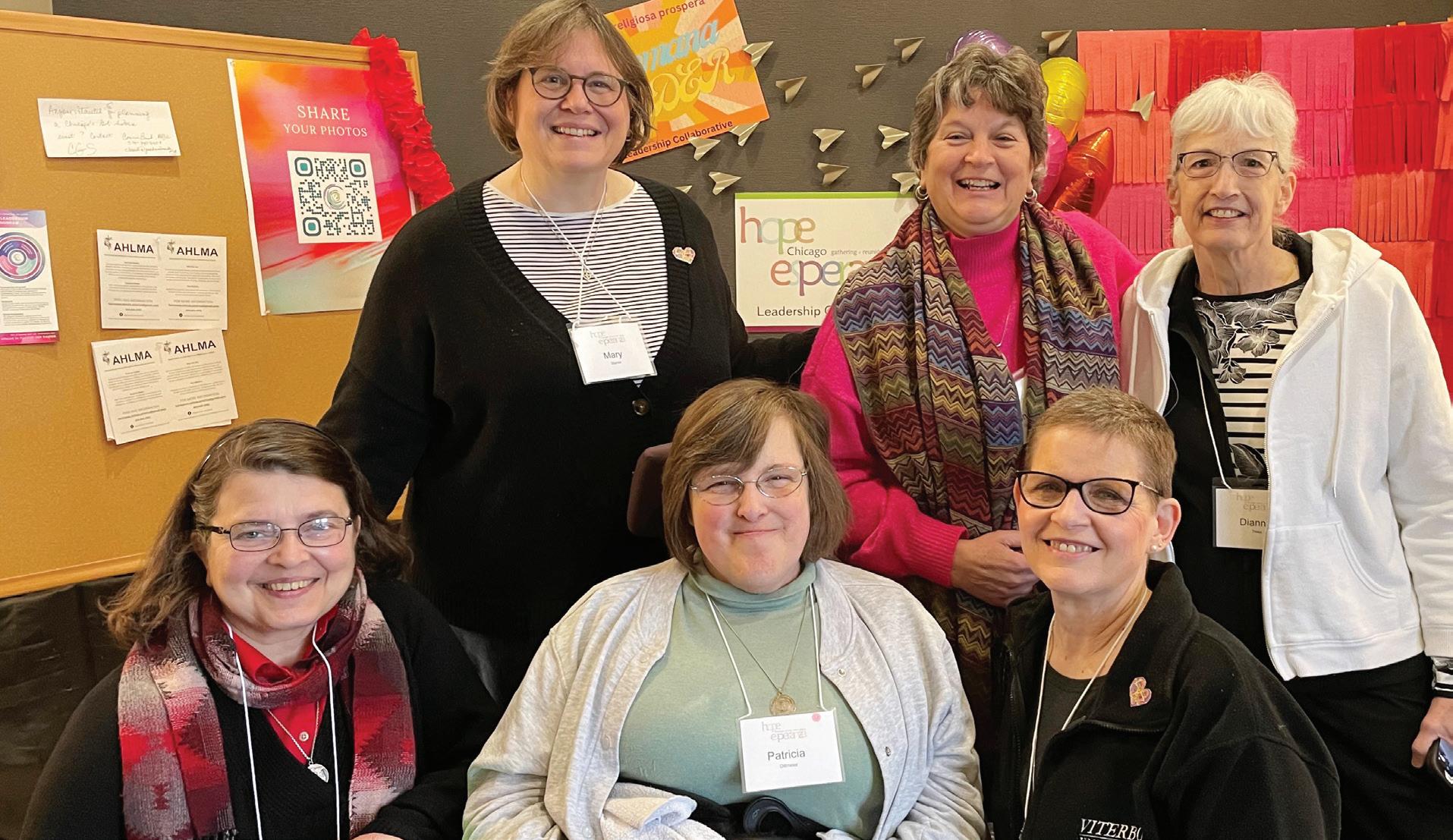 Sisters from the SC Federation enjoyed the opportunity to connect with each other and others during the January gathering.
(Front row, from left) Sisters Montiel Rosenthal, Pat Dittmeier and (back row, center) Monica Gundler attended the gathering which included Sisters from 108 congregations and 26 different countries.
Sisters from the SC Federation enjoyed the opportunity to connect with each other and others during the January gathering.
(Front row, from left) Sisters Montiel Rosenthal, Pat Dittmeier and (back row, center) Monica Gundler attended the gathering which included Sisters from 108 congregations and 26 different countries.
VOLUME I, 2024 5
S. Romina Sapinoso (left) at the Leadership Collaborative’s Hope-Esperanza gathering Jan. 25-28, 2024, in Chicago, Illinois.
S. Montiel Rosenthal
Shared experiences and networking regarding our experiences and leadership, and discernment of individual and communal ministry, were rich, and happened in side discussions, over a cup of tea, and in between and after formal sessions. These experiences are invaluable and really only happen in the context of face-to-face listening and storytelling. Making connections such as, “you really need to meet with … you and she would find so much resonance in your hopes and plans,” happened daily.
S. Mary Ann Zollmann, BVM, one of our wisdom reflectors, reminded us “vulnerability is the essence of leadership,” and so the challenge of this assembly is, in what ways do we draw on this international sisterhood moving into a new era of religious life? We cannot just pick up “something new.” We need to identify nonessentials and let them go. We need to be courageous in the face of our own fears, be vulnerable enough to trust one another, and rely on God daily to lead us to a kin-dom more precious and splendid than we can presently imagine.
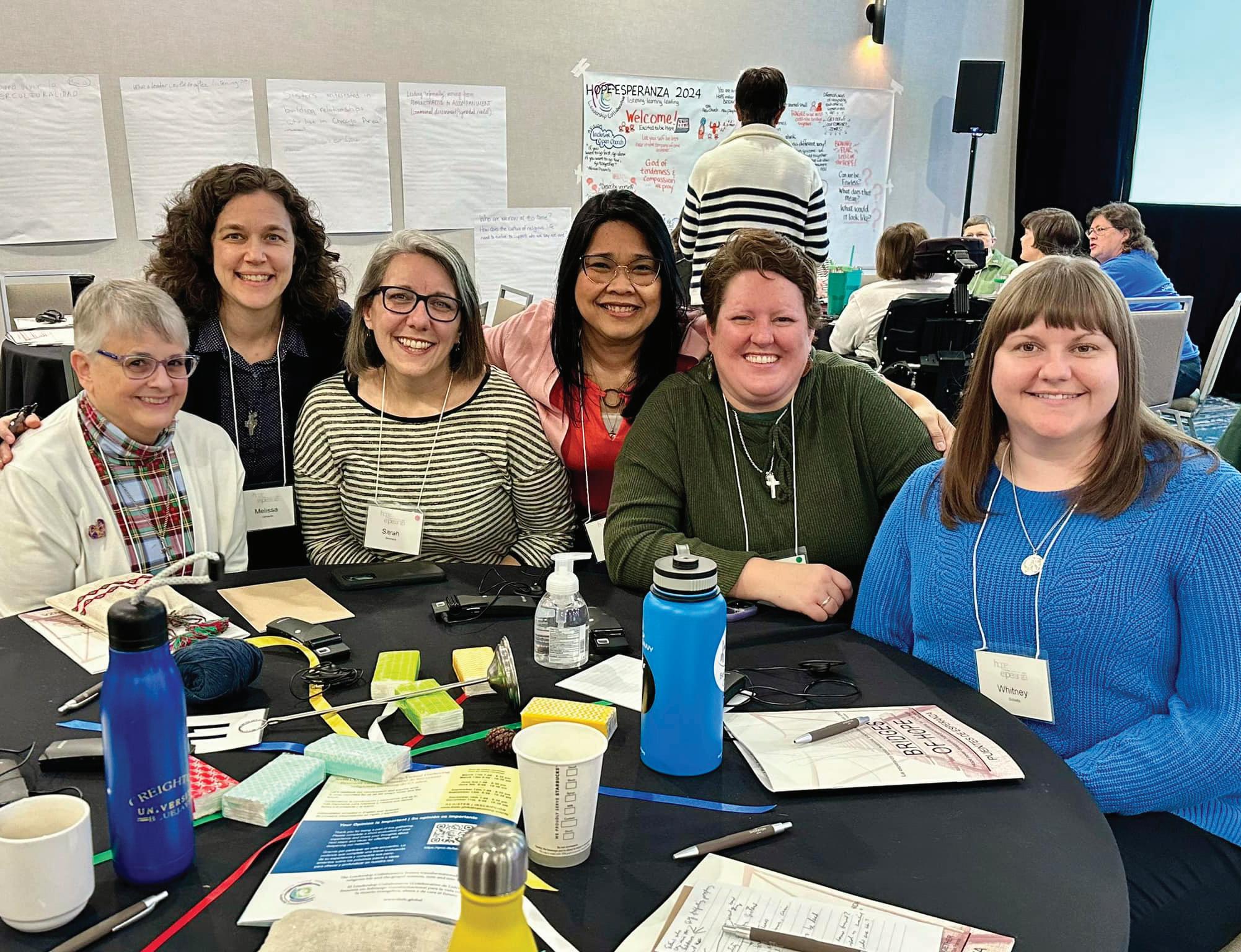
central a role it played. Particularly, I was intrigued by the focus on vulnerability as a crucial quality of leadership.
S. Derby, a Sister of Mercy from the Philippines, prompted us, “Shared leadership is not a burden, it is a joy,” reminding us of our mutual responsibility to be vulnerable, collaborative, Spirit-led; to believe we are enough; to acknowledge our fears but boldly lead into the future; to tap into what we need to be fully alive in religious life today; to be inspired by and inspire others; and to be kind to children – of all ages.
Eyes sparkling in recognition of old friends and new acquaintances made. Warm hugs, prayer, song and laughter shared. Threads of shared stories. Shy hopes for the future offered in affirmation of similar dream fragments coming to birth. Living into a future life form of religious life. These are but a few of my reflections on the experience of this weekend of Hope-Esperanza.
S. Whitney Schieltz
I wasn’t totally sure what to expect from the Hope-Esperanza 2024 gathering, but judging by the event name and a brief description on the registration page, I knew it would involve encouraging conversations about the present and emerging reality of our global sisterhood. The fact that this gathering was being hosted by the Leadership Collaborative should have been a clue that the theme of leadership would be woven throughout the weekend; yet, I was still surprised by how
After listening to a panel of Sisters share their reflections and viewing Brené Brown’s TED Talk, The Power of Vulnerability, we were asked to ponder and discuss the relationship between leadership and vulnerability. The insight that I found most inspiring was the paradigm shift from leadership as administration to leadership as accompaniment, especially in religious life. In other words, we should be more concerned with how we are available and present than with what we do and achieve. As one Sister pointed out, when we look at Biblical leaders like Moses, God’s assurance is of accompaniment – I am with you – not a guarantee that everything will be easy and successful. As faith-filled women called to be leaders in our Church and our world, we must be fearless and lean into discomfort, trusting that our God – and our fellow Sisters – will be with us along the way.
Finally, I continue to pray with the questions of: “What am I/are we called for today?” and “What do I need to be fully alive in religious life today?” The words that keep coming to my mind are: giving witness to the joy of the Gospel. As we read the signs of the times and see so much division, isolation, and despair in our world, women religious are called to be models of connection and hope, which requires us to develop healthy relationships, build loving communities, and embrace mystery with joy and humor. We may not be able to predict the future, but in the sharing of our lives together, in our vulnerability, and in our bravery, we can help co-create a better tomorrow.
Introduction written by S. Tracy Kemme.
6 INTERCOM
S. Whitney Schieltz (right) was intrigued by the gathering’s focus on vulnerability as a crucial quality of leadership.
Celebrating a Saint, a Star, a Season: An Associate Day of Reflection
By Associate Karen Martin
They came with anticipation, inquiry and excitement.
Associates arrived at EarthConnection on Jan. 6, the Feast of the Epiphany, to pray, reflect, converse and share in friendship. Everyone gathered joyfully, greeting cherished friends and meeting new ones. They were mindful of the Sisters convening at the Motherhouse for their day of prayer and reflection. It was truly a day of spirit accompaniment for the Charity Family.
Being the Feast of the Epiphany, the star of wonder summoned the Associates to “meet our grace.” On arrival participants made a paper star from three triangles. The triangles represented the three kings, the three virtues of simplicity, humility and charity, the three comings of Christ, and the Trinity. Stapled together the star served as a simple medium to record thoughts throughout the day, and a reminder to follow the Divine Light. They brought gifts of information, rhythm and friendship.
Jennifer Melke-Marks shared inspirational presentations, commemorating the Feasts of the Epiphany and Elizabeth Ann Seton. She explained, with an excellent PowerPoint presentation, the rhythms of Advent, the waiting time; of Christmas, the birth of the Son; and of the Epiphany, the manifestation of the Divine. She evoked the life and teachings of Mother Seton and her invitation to live the Charity Charism.
Nancy Bick-Clark shared the rhythm of the changing seasons and the relationship of the natural and spiritual. She offered daily changing views of the sun photographed from her home and explained the Celtic calendar. Nancy led the Associates in rhythmic songs. Throughout the day she played celestial harp music providing tranquil sounds for sacred ambience.
Before lunch, via a one-hour Zoom, Associates from near and far shared an Irish-inspired celebration of the Epiphany, called “Women’s Christmas.” Since we had recently celebrated the Feast of Elizabeth Seton, our model of a dynamic American woman saint, this Epiphany celebration was relevant. The title was renamed “Friends’ Christmas” to signify Associate inclusivity. Elizabeth Seton modeled the gift of special relationships with those apart from her through her frequent letters. The Internet was unavailable!
It was Epiphany. The Magi’s gifts symbolically revealed personal transformation. Balthazar’s gold advocates giving everything to God and living humbly. Casper’s frankincense

acknowledges that all life is sacred. Melchior’s myrrh offers inner peace. Their return journey invites living in different ways. Through the Zoom conversation everyone gratefully acknowledged friendships and gifts shared through association with the Charity Family.
They shared conversation, camaraderie, prayer and ritual.
Associates moved within the EarthConnection rooms (inclement weather outside) for individual silent reflection and prayer. Following these times the participants met both in small groups and with the larger group to share the challenges and celebrations from their personal experiences. The day concluded with prayer, song and a “star ritual.” Associates placed their stars on the altar displaying a glistening star shining on a statuette of Elizabeth Seton and the figures of the Magi that were arranged on a layer of straw resembling the nativity stable floor. Each person took a piece of the straw with them to remember the day’s teachings from Elizabeth Seton, the revealing manifestation of the Epiphany star, the Magi transformation, and vital conversations and prayer shared with each other.
They left transformed, with enhanced inspiration, awakened spirituality and energized hope to “meet our grace.”
It was good to follow the Divine Light in relationship with the Charity Family. Associates were motivated to go in different ways to comply with Elizabeth Seton’s challenge to “Hazard Yet Forward.” It was a Spirit-led day!
VOLUME I, 2024 7
The day of reflection concluded with Associates placing paper stars on the altar to highlight a glistening star shining on a statuette of Elizabeth Seton and the figures of the Magi.
WLove Without Borders
hile Congress recklessly squanders time disputing border security, two Sisters of Charity, occasionally three, quietly, without incident, make their daily trip through that border from the United States to Anapra, Mexico. They return by evening. The Sisters, Carol Wirtz, Andrea Koverman, and Peggy Deneweth, are committed to the growing ministry they have planted and fostered since 2001 now called Proyecto Santo Niño in Anapra, Mexico, right over the U.S. border from New Mexico.
By S. Mary Ann Flannery

According to a report by Christopher Calott given at the annual Outposts of the Americas meeting, Anapra is a “30,000 person squatter settlement on the outskirts of Ciudad Juarez which emerged overnight and literally crashes into the international border and is met by an INS fence.” It is one of the poorest, if not the poorest, of Mexico’s outlier communities created by immigration and the ruthless preying of the drug cartels.
“Initially, our ministry started in 1991 working with the Daughters of Charity at their San Vicente Clinic in El Paso. We eventually left there to develop La Clinica Guadalupana, in a community that had neither infrastructure nor any type of health services,” said S. Carol Wirtz, who provided lymphatic and movement therapy. The Sisters, under the leadership of the late S. Janet Gildea, a physician, provided health care mostly for poor women and children.
“Eventually, S. Janet began to see that education was more important – or equally as important – as medical care,” continued S. Carol. “Janet kept saying, ‘Somehow, we need to educate,’ when we saw more women coming to us to volunteer in gratitude for the help they received. We built a little community with the mothers and taught them how to help others. We would always say in our prayer, ‘Do what presents itself.’”
In 2003, after efforts to help parents and children with clinical health needs, Proyecto Santo Niño was born. In the meantime, S. Carol, a teacher by training, happened upon a televised Ted Talk with Anat Baniel, creator of the method of NeuroMovement Education® centered in California. The basic premise is that “the brain is made for change,” according to the program’s website. That the brain can change is a theory
embraced by many neuroscientists and neurologists today and is usually referred to as neuroplasticity of the brain. S. Carol was enthusiastic about what the method promised, especially after more children who were coming to the clinic were increasingly suffering from neurological disorders. With the support of the Sisters of Charity, S. Carol enrolled in the three-year certification program in California. “NeuroMovement® helps a child to organize thoughts and movement, in all kinds of disabilities from the physical to the mental. We can help these children,” says S. Carol. Essentially, “the method provides information to the brain to help organize thoughts through movement.”
In 2018, S. Carol received her certification in the Anat Baniel Method of NeuroMovement and Education® for special needs children. S. Janet transitioned her ministry to vocation and formation, leaving the work of education to the educators. Unfortunately, she passed away in 2019, but S. Carol kept the dream alive until Sisters Andrea Koverman and Romina Sapinoso, both professional educators before entering the congregation, arrived on the scene. They recognized the need to develop a system in which children of multiple ages and abilities could learn side-by-side in the same environment and decided the Montessori method would be ideal. Each woman embarked on a two-year study program but didn’t wait to implement the curriculum. S. Andrea explained, “It was definitely a learn-asyou-go process!”
By 2023, they had created a Multiple Level Montessori Program for very young children through adolescents, hired a speech therapist and two professional teachers, one in Montessori education and one in Early Childhood and Special Education. Proyecto Santo Niño is an inclusive school with programs for students with special needs as well as typical learners desperate for educational support out of their extreme poverty. S. Andrea adds, “… we teach the children to encourage and support one another as equal members of a learning community.” The limited space has been reconfigured more than once to accommodate the growing demand. And still, more room is needed.
Where are they now? S. Peggy smiles broadly at the
8 INTERCOM
S. Peggy Deneweth has lovingly ministered at the U.S.-Mexico border for more than 20 years.

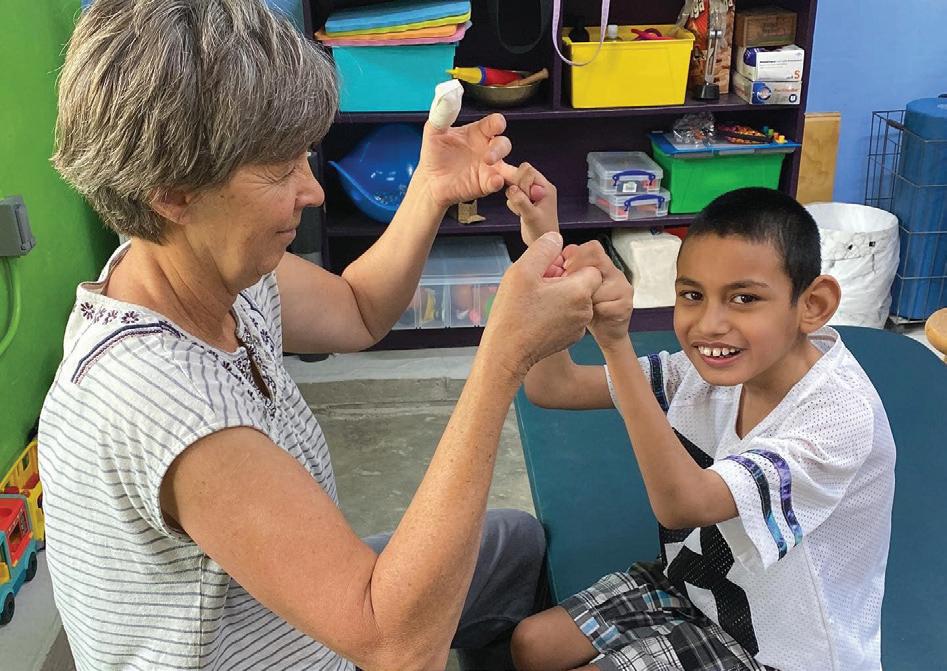

question. She has become the business administrator of the ministry complex, something she never thought she’d be doing in her life. S. Romina relocated to Cincinnati while S. Andrea runs the school, and provides the special education services to students with a wide range of handicapping conditions. For most of the past year, the Sisters hosted pre-entrant, Sandra Ramirez, who also taught in the preschool as an Associate in Community/Ministry. S. Carol provides movement lessons for the students with cerebral palsy, spina bifida, epilepsy, Down Syndrome and autism. She also coordinates the other related services provided including speech/language therapy, and physical and occupational therapies. S. Carol says, “Connecting with the kids is miraculous. It gives me deep joy. I’m in the presence of love.”
Sisters Carol and Andrea attribute the sometimes downright miraculous progress the children make to the complementarity of movement and Montessori educational programs. For example, there’s the little girl who was born with a paralyzed arm but now she can raise it normally and use it like the other arm; the 9-year-old who was dismissed from the public school because “he is stupid” according to his teacher but loves to play chess and is now flying through the math curriculum; the little girl with Down Syndrome who is now reading; and the once severely autistic boy who could not
relate to anyone but now waits for the Sisters’ arrival every day at the school door.
Programs themselves do not transform lives. The “secret ingredient” is love. S. Carol thinks often of the scriptural mandate, “Remember the anawim (Hebrew word meaning the ‘poor’).” One time in prayer she is sure she heard, “You are loved, you are seen,” words that motivate her when she looks at the children: they are loved; they are seen.
Who would ‘see’ these children if not the Sisters of Charity? S. Andrea points out that remnants of superstition and shame still drive parents of special needs children to hide them and the school system does not accept many of them. They are children in the shadows. She adds, “Our learning is to appreciate who is in front of us.”
The Sisters of Charity are committed to change this mindset and bring these children out of the shadows with the miracle of good health, the conquering of disabilities, and the thrill of education to unlock a promising future.
To subscribe to the Proyecto Santo Niño newsletter, contact proyectosantonino@aol.com.
Please consider donations by visiting the website, Proyecto Santo Niño. You can also send donations made out to Proyecto Santo Niño and mailed to:
Sisters of Charity
260 Sombra Verde Anthony, New Mexico 88021
VOLUME I, 2024 9
S. Carol Wirtz provides highly specialized neuromovement lessons for the physically and developmentally challenged students of Proyecto Santo Niño.
Proyecto Santo Niño in Anapra, Mexico.
S. Andrea Koverman is director of Santo Niño’s Multiple Level Montessori Program for very young children through adolescents.
Building Bridges:
Addressing the Root Causes of a Broken Immigration System
By S. Sally Duffy
Our broken immigration system in the United States has been breaking persons and families for decades. Forced migration is resulting in deaths in the desert, abandoned tractor-trailers, the Rio Grande River, mass shootings, etc. We are nearing the end of the Easter Season, could we preach the Gospel and use words if necessary by taking immigrants down from their cross? Immigrants, especially those currently experiencing forced migration, can then experience abundant life.
The facts do not support the fear-based narratives and the lack of engagement with immigrants. The Carnegie Corporation of New York on Sept. 27, 2021, published an article written by Alex Nowrasteh of the Cato Institute offering nonpartisan facts and graphics in response to common myths about immigration in the 43-page report, “The Most Common Arguments Against Immigration and Why They’re Wrong.” Here are a few of the 15 myths.
Myth: “It is easy to immigrate here legally. Why don’t illegal immigrants just get in line?”
Fact: It is very difficult to immigrate legally to the United States. Immigration law is second only to the income tax code in legal complexity.
Myth: “Immigrants abuse the welfare state.”
Fact: Immigrants use significantly less welfare than nativeborn Americans do.
Myth: “Immigrants increase the budget deficit and government debt.”
Fact: Immigrants in the United States have about a net zero effect on government budgets — they pay about as much in taxes as they consume in benefits.
Myth: “Immigrants are a major source of crime.”
Fact: Immigrants, including illegal immigrants, are less likely to be incarcerated in prisons, convicted of crimes, or arrested than native-born Americans.
Myth: “The United States has the most open immigration policy in the world.”
Fact: The annual inflow of immigrants to the United States, as a percentage of our population, is below that of most other
rich countries in the Organization for Economic Cooperation and Development.
Myth: “The brain drain of smart immigrants to the United States impoverishes other countries.”
Fact: The flow of skilled workers to rich nations increases the incomes of people in the destination country, enriches the immigrants, and helps (or at least does not hurt) those left behind.
Immigration terms are often misunderstood. Refugees come to the U.S. with legal documents allowing them to enter the country. Refugees are resettled stateside. This allows them to get state IDs, jobs, housing, etc.
Asylum seekers do not come with all documents; therefore, it is much more difficult to get jobs, housing, etc. It requires a great deal of legal help to get these documents. Those unable to get legal assistance are often deported back to their home country. Asylum is a discretionary form of legal relief for someone who seeks safety in the U.S. based on “persecution or a well-founded fear of persecution on account of race, religion, nationality, membership in a particular social group, or political opinion.” Asylum seekers arrive to the U.S. before seeking protection. Asylees who win their cases gain access to a pathway to lawful permanent residence — and eventual citizenship — in the U.S.
The National Immigration Forum Asylum Explainer states: “If someone is before USCIS (U.S. Citizenship and Immigration Services), their estimated wait time is more than six years. Asylum seekers are looking at an average wait time of approximately 4.3 years.”
Due to forced migration because of poverty, conflict, climate change, natural disasters and persecution are strong push factors that drive migrants to seek safety, self-sufficiency and protection for their families in other countries. Desperate persons and families are forced to risk and flee, and do not always know what they will face when they arrive at the U.S. border. Smugglers, motivated by profit, find alternative ways to provide entry into the U.S. Deterrence is a shortterm solution but what is needed is integral comprehensive immigration reform. Integral because everyone has the right to be seen as a whole person, and integrated into communities through shared membership.
10 INTERCOM
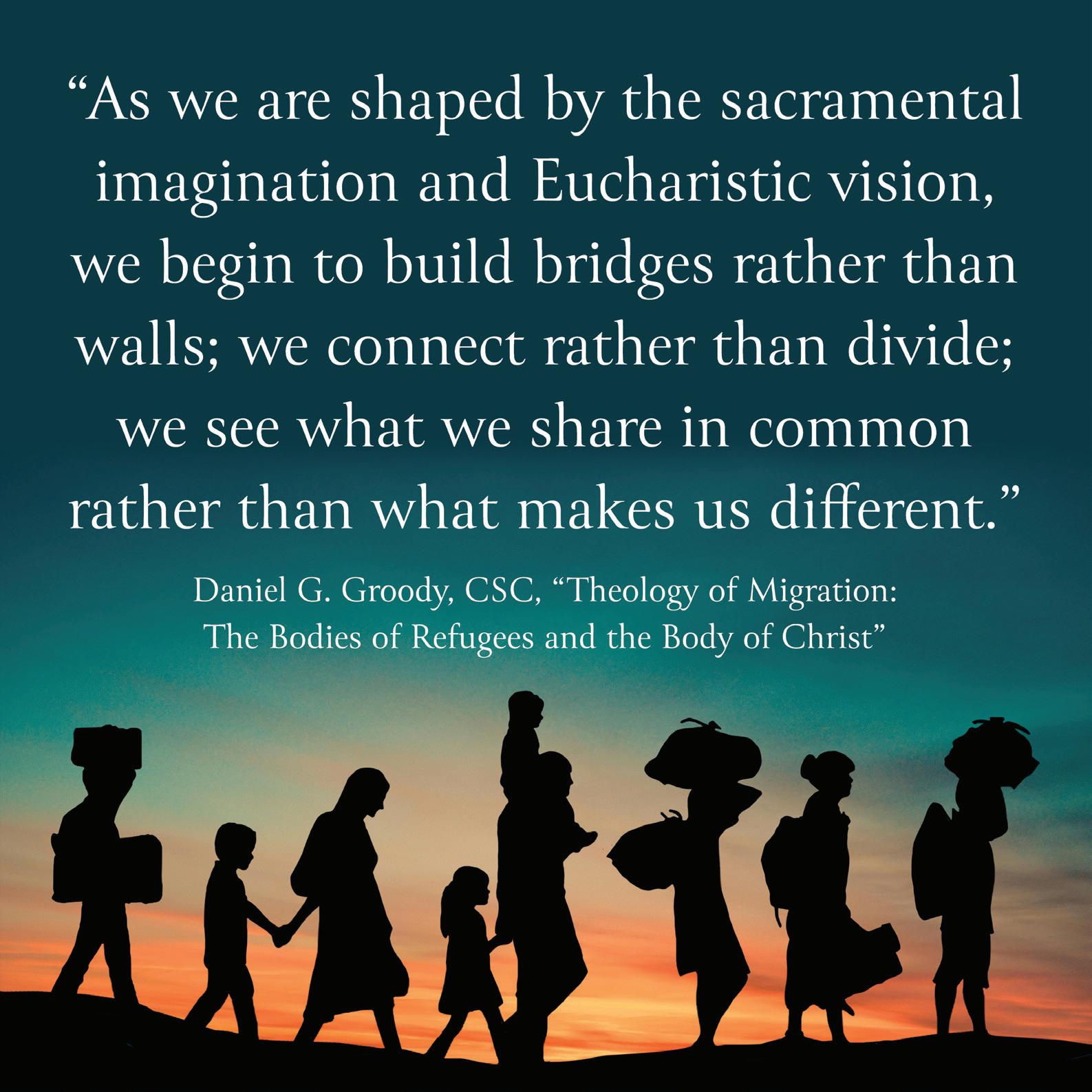
The Center for Migration Studies, a think tank focused on Catholic Social Teaching, published a statement on Jan. 8, 2024 on “How to Manage the Border Without Sacrificing Human Rights.” The statement concluded:
“The nation’s legal immigration system is antiquated and needs revision. Immigration reform would revamp both the family and labor-based system to allow immigrants to migrate legally and in a timely fashion, thus reducing pressure on the southern border.
“Over the long-term, the United States must also deploy a strategy, in cooperation with Mexico and Latin American nations, to address the root causes of flight, including poverty, conflict, and governance issues.
“As part of this strategy, the United States must also examine its foreign policy toward countries in the hemisphere, especially economic policies that may adversely impact the livelihoods of migrants and their families. The government and the world community also must take seriously the impact of climate change on flight, and begin to address its effects.
“The policies being considered by Congress and the administration take the nation backward in terms of
immigration policy. They basically reflect the anti-immigrant policies of the previous administration, a punitive enforcement-only model which has failed over the past 40 years.
“The Biden administration and Congress should reject these policies and instead return to a bipartisan process to reform the U.S. immigration system. The nation can create a system which balances immigration and the rule of law, serving the best interest of the country into the future.”
Daniel G. Groody, CSC, in his excellent book, “Theology of Migration: The Bodies of Refugees and the Body of Christ,” writes of a new narrative about migration. “As we are shaped by the sacramental imagination and Eucharistic vision, we begin to build bridges rather than walls; we connect rather than divide; we see what we share in common rather than what makes us different. Because the walls we build around us are only outwardly visible signs of the walls we build within us, the work of the human journey is the work of reconciliation. If we alienate ourselves from those in need, we not only become aliens to our own humanity, but we also deport our own hearts into a foreign land.
“A life of authentic worship leads us to look at the world differently because it realizes that we are not just migrants in this world but also pilgrims in it. We journey just not as tourists toward some general destination but as children of God walking toward the eternal homeland and a lasting dwelling. The more we become transformed by the One who has first loved us, the more we will find our way to our homeland” (Page 303).
Like Elizabeth Ann Seton, we must be totally reliant on God as we walk on our journey of life. By walking together with our immigrant brothers and sisters, we may think that we are saving immigrants but learn that they are saving us.
VOLUME I, 2024 11
Commitment from a Distance
By Katelyn Rieder, Communications co-op
On Jan. 7, 2024, nine women from Florida made their commitments as Associates in Mission of the Sisters of Charity of Cincinnati. Despite not being in close proximity to Mount St. Joseph, these individuals all became uniquely attracted to the congregation, and are now connected through the Associate relationship. Read some of their stories below:
Pat Augustyniak lived in Liverpool, England, until she was 24. During this time she had two sons and one daughter with her first husband. She then moved to London for a number of years before settling in Brooksville, Florida, in her early 40s and remarrying.
As she converted to Catholicism in 2022 and joined her husband’s church, Pat remarked that she felt like “a deer in headlights” at first. However, this did not stop her from getting involved. After she had been asked by two different individuals from her church to consider becoming an Associate, she agreed.
“My fellow Associates are devoutly devoted to the Church and to each other, and it’s beautiful,” she said. “Going to our meetings and hearing their hearts is very compelling to me. That’s why I’m an Associate.”
Diane Clark has spent the last 20 years living in Florida with her husband, Joe. She has both an associate and bachelor’s degree in nursing, and worked in the field until retiring in 2017. At home, she enjoys reading, crocheting, and relaxing with her cats (Maxwell and Sophie).
When her parish reached out to get people to participate more in stewardship, Diane immediately recognized the Associates of the Sisters of Charity, as a few of her great-great aunts were women religious. As an Associate, she finds the charity aspect to the congregation most powerful. She said, “There are so many ways that I can make a difference for people that really need to be supported in the community. I always just want to help others and make things better for other people.”
Mary Crouse recently retired in 2023 after working as a realtor for 17 years. She also was the founder for a local chapter in Florida of “100+ Women Who Care,” an organization that helps raise money in support of charities in the community.
She comes from a large family (six brothers and four sisters) and has two daughters. In her free time, Mary enjoys outdoor activities such as biking, walking, and fishing. She
also appreciates reading, watching movies, and baking.
Her local parish motivated Mary to become involved with the Sisters of Charity. “The phrase ‘iron strengthens iron,’ comes to mind when thinking of becoming an Associate,” she said. “Through sharing a desire to serve the Lord through small acts of love, generosity, and faith with other Associates, we strengthen each other in our walk with the Lord in prayer and service.”
Lee Dolan has been aware of the Sisters of Charity since she was accepted into the College of St. Elizabeth (now St. Elizabeth University) in Morristown, New Jersey, where she earned her degree in nursing. At the same time she was studying, Elizabeth Seton was canonized.
She said, “I was not born or raised Catholic, but I became interested in St. Elizabeth at that point because there was so much in the newspapers and so much going on about her.” Lee went on to convert to Catholicism in 1979, but became disillusioned with the Church after several years. When her husband passed away, she felt incredibly moved by the Catholic funeral. This experience further connected Lee to Elizabeth Seton, who is the patron saint of widows. When Lee came back to her local church, she met another Associate who motivated her to apply.
Nancy Henry grew up in Allentown, Pennsylvania, and moved around the state for many years until settling in Florida. She graduated from Gwynedd Mercy College in 1988 with a bachelor’s degree in health science management, and worked in the healthcare field for many years. At the age of 73, Nancy formally retired, but still wanted something to do with her new-found free time. From there she began working as a substitute teacher in her local district. At home, she enjoys various artistic hobbies, like painting and putting together puzzles. She also belongs to the St. Francis of Assisi Council of Catholic Women and volunteers with St. Vincent de Paul. Similar to some of her fellow Associates, Nancy became familiar with the Sisters of Charity through her local parish, and became connected with the mission and charism of the congregation.
Kimmarie Lopez has always been a faith-filled woman. After facing several difficult major life changes, she has strengthened her relationship with God. As a way to honor God for all He has done for her, Kimmarie has become involved with both St. Vincent de Paul and the Sisters of Charity. She said, “I am passionately committed to being an
12 INTERCOM

Associate and feel honored that I have been called to serve others in this capacity and look forward to doing God’s work through this beautiful ministry.”
Pat McNiff reflected that she has always had a “servant’s heart,” even if it took her a while to realize it. When she eventually came into contact with the Sisters of Charity, she felt like she was home. “Learning and reading about the founders of the Sisters is so empowering to continue their work in the community,” she shared. “I love our time together as Associates because of our prayers, caring about each other, sharing our talents but most of all continuing to spread the good news of Jesus Christ!”
Janet Parente was taught by the Sisters of Charity of Halifax growing up in New York, and through them learned about the life of Elizabeth Seton. She worked in various nursing facilities from 1974 to 1993, when she and her daughter moved to Florida. She remained in the field until 2017 when she officially retired. Today she works part-time as a receptionist for her parish—St. Francis Cabrini Church. It was in this role that she became more and more familiar with the Associates in her area, who encouraged her to apply. “Ministering to the parishioners is a wonderful way to spread God’s love,” she shared.
To summarize her reasoning for becoming an Associate, Janet said, “I’m travelling on my spiritual journey and looking for support to live out my faith.”
Several individuals gathered to welcome nine Associates to the Sisters of Charity on Jan. 7, 2024. (Front row, from left) Margaret Martin, Deacon Bob Anderson, Gail Metcalf, Anna Nelson, Nancy Henry, Pamela Record, Cindy Chase, Liz Hickey, (second row, from left) Mary Crouse, Heather Litton, (third row, from left) Debbie Garland, Chanin Wilson, Gin Poisson, Cathy Palmer, Peggy Brockman, Kimmarie Lopez, Pat Augustyniak, Diane Clark, Janet Parente, Geri Anderson, Pat McNiff, and Father Jose Tejada.
Pamela Record and her family moved to Florida when she was 12, and has lived there since. She worked in various nursing facilities as an aide and secretary for many years before retiring. In her spare time, she loves to read and create custom bookmarks for herself and others. She also loves spending days with her brothers, nieces, and nephews.
After an event held by her local parish, Pamela asked one of the Associates there to explain to her the relationship and commitment. This initial curiosity would lead her to make the decision to become involved. To combine her passion of reading with the Associate relationship, she has begun reading “At the End of the Santa Fe Trail” by S. Blandina Segale. “It’s very interesting,” said Pamela. “She went through so much that I wouldn’t have ever known about.”
The Sisters of Charity Community is incredibly blessed to have these amazing women as part of the Associate commitment. Their compassionate spirits are appreciated by the entire congregation. Welcome, Associates!
VOLUME I, 2024 1 3
Welcoming the Stranger
By S. Patricia Wittberg
Between now and November we are likely to hear much rhetoric about “the crisis at our southern border” and “the need to fix our broken immigration system.” S. Nancy Crafton has a unique and close-up perspective on these issues, since she helped found Los Pobres Center in 2000 and has administered its services ever since. Located in Avondale, Colorado, on the outskirts of Pueblo, Los Pobres Center helps some 900 families from five surrounding counties with food, clothing, medical care, education, and immigration issues.
Recent developments have added to the center’s ministries. Migrants, fleeing gangs or looking for work to feed their families, walk for months through Central and South America and arrive at the U.S.–Mexico border sick and desperate. S. Nancy tells the story of one mother who came here with her three children to rejoin her husband and his parents. She had advanced cancer and could not find medical care in her home country. By the time they arrived at Los Pobres, she had to be admitted to hospice and died in six weeks. Two other mothers from Venezuela, both pregnant, journeyed on foot for three months. They had their babies three weeks after arriving at Los Pobres. Since Venezuela is one of the countries our government classifies as a special case, they were able to get Social Security Numbers and work permits. Migrants from Nicaragua, Guatemala, Ecuador, or El Salvador – to say nothing of those from Haiti, Mali, the Congo, or China who also make the trek – are not so lucky.

the migrants and keep them in “holding pens” for three or four weeks. There may be up to 400 people waiting at any one time. The cartels feed them one meal a day – a tablespoon of rice and some salsa – and they have to pay for any water they drink. Periodically, they have to call their families and request more money to give their captors. Their cell phones are confiscated and replaced with different phones, modified so that the cartels can track where they are going and where their relatives are. When there are enough persons going to the same general area, the cartels pack them into a car and drive across the border by back roads or tracks. They usually squeeze nine persons into a single sedan-sized car, two of whom are crammed into the trunk.
How do the migrants waiting across the border get to Pueblo? That is where the cartels come in. Yes, the same cartels who smuggle drugs into this country. But the migrants aren’t smuggling drugs. They are being smuggled themselves. They are simply another “product” the cartels exploit to make money. It is a very lucrative racket: desperate families whose crops failed in Central America’s drought, or who were threatened by local gangs, are lured by the cartels who say the United States will welcome them and give them jobs. The cartel promises to transport them across the border “for a small fee.” S. Nancy says the cartels first find out where they want to go in the United States; then they extort fees from
Pueblo is located along I-25, the main highway from the southern border to points north. Of course, the New Mexico and Colorado police are trying to stop the trafficking on this route. When they intercept one of these suspicious cars, the driver usually abandons it and flees. The police are left with the nine or more very frightened migrants – usually single adults, but some as young as 7 or 8 years old. What to do with them? Los Pobres Center is the only place in Southern Colorado that will help, so the police bring them there. S. Nancy says the migrants are terrified at first, thinking they are going to be jailed and deported. The first thing they see is the center’s huge tapestry of Our Lady of Guadalupe, which helps
14 INTERCOM
Among the many services offered at Los Pobres Center in Avondale, Colorado, is a clinic for medical help.
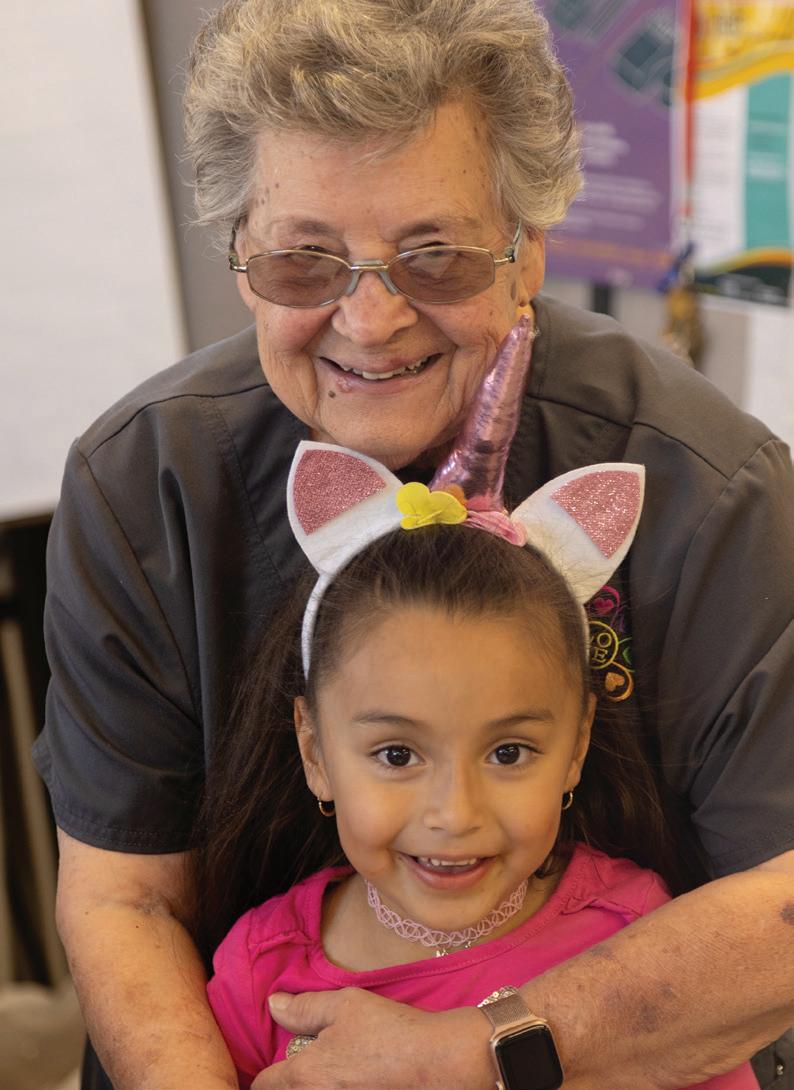
S. Nancy Crafton has lovingly served migrant workers and their families at Los Pobres Center in Avondale, Colorado, for more than two decades.

A registered nurse, S. Nancy Crafton runs Los Pobres Center in Avondale, Colorado, a center that provides services and items, including but not limited to food, donated clothing, toiletries, financial help and medical care to more than 200 migrant families per week.
them relax a little. But they are still frightened. The center will discard the phones given to them, and let them use the center’s phones to call their families.
S. Nancy and the Los Pobres volunteers give the migrants food and clothing. They help with medical care – one young girl’s legs were so swollen after being packed tightly in the car for days that they had to cut her jeans off. Immigration Services then comes to interview them to make sure they are not cartel members themselves, and to see if they have been forced, raped, or held at gunpoint during their ordeal. If they have, they can apply for protection and receive work papers. Los Pobres Center’s volunteers put the migrants up in hotels and send them on the bus to join their relatives or friends. Not that their troubles will be ended after that; S. Nancy wonders about the 8-year-old boy in a recent car who was going to an uncle in New Jersey. Will he go to school or be put to work in his uncle’s construction business?
The news media in this country, S. Nancy says, feed us so many myths about the migrants. They are not “mules” bringing in drugs. When you cram nine persons in a small car, there is hardly room for contraband. The migrants are not coming here to live off our welfare programs. They want to work. Those who are undocumented must pay U.S. taxes, but will never be able to collect Social Security, Food Stamps, or other government assistance. They are not taking work from Americans: they are doing jobs – in the fields, on roofs, in meatpacking plants, in landscaping – which Americans do not want to do. They are not coming here to engage in criminal activities. S. Nancy related how she told one carload
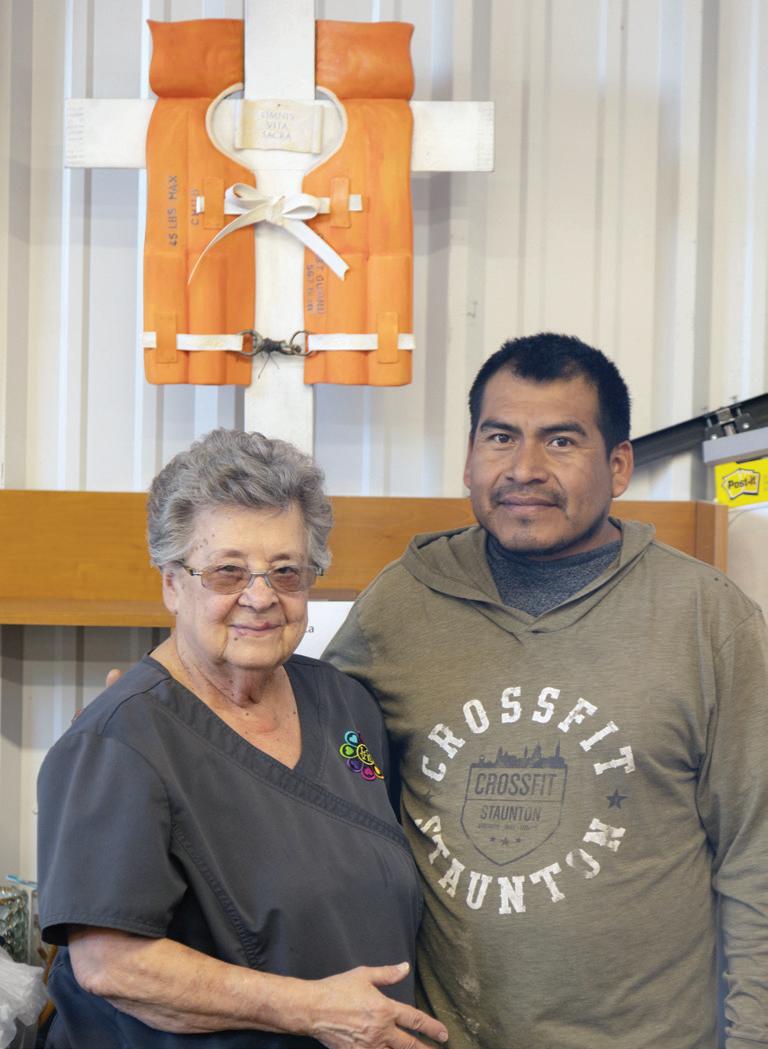
The cross displayed at Los Pobres Center in Avondale, Colorado, was designed by an East Coast artist to honor those who died crossing water without life jackets.
of migrants that they could take a shower at the center. All nine did so, but she didn’t mention they could open the linen closet and use the towels there. They all used the same towel rather than open a closet door without permission. Even when migrants receive protection in the United States, it is temporary. They must wait many years for a hearing and may be deported afterwards. S. Nancy has seen people deported who have lived here many years.
There is a crisis at our border. What can we do to help resolve it? S. Nancy says the Sisters and Associates are already doing a lot with our Newcomers Program, the Immigration and Human Trafficking Justice Circle, and individual efforts. But all of us can do our part. We can vote and let our representatives know that we want a truly humane immigration policy. We can speak out and tell the truth when our relatives and friends mention some of the myths about immigrants.
In the meantime, S. Nancy finds joy in the wonderful volunteers who help at Los Pobres Center. Some volunteers come from as far as 20 miles away. Some are from the 900 local families that the center regularly helps: they know the sufferings the migrants are experiencing because they, too, have suffered. Some volunteers are the migrants themselves, who help others even while they are being helped. They remember Christ said, “I was a stranger and you welcomed me.”
All photos accompanying this article are courtesy of Brother Gary Sawyer, Associate.
VOLUME I, 2024 15
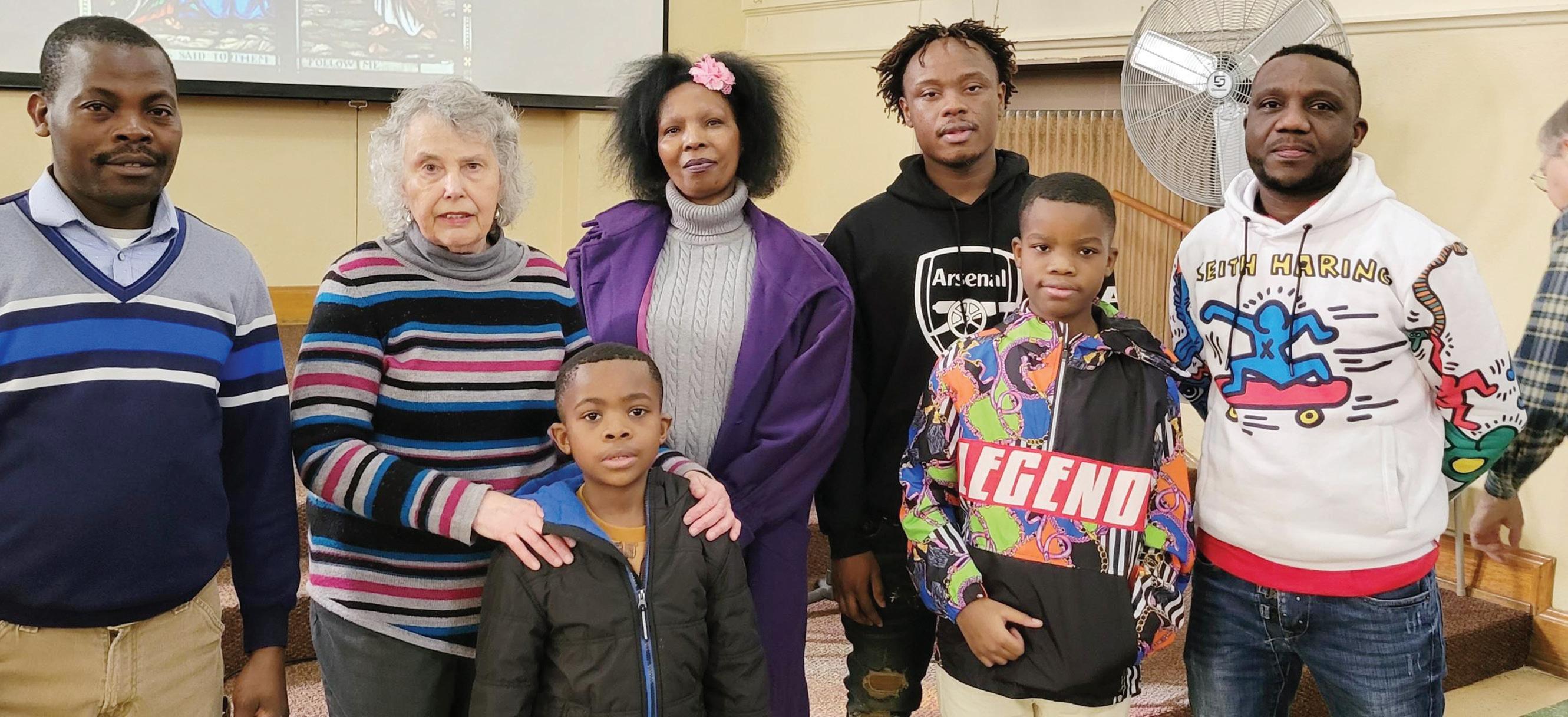
Experiencing God’s Love
By Associate Dave Scharfenberger
When Angela Anno made her commitment as an Associate of the Sisters of Charity of Cincinnati in April 2023, she found a connection with the SC motto, “The Charity of Christ Urges Us,” a theme that she has tried to live out most of her adult life. As she so eloquently stated in her discernment statement, she “experienced the love of Christ in all people – a giving and receiving of the gift of each person, not a handout that makes me feel good but a willingness to enter into relationship with others, often unlike myself.”
Angela has lived through the pain and challenges of seeing others she loved suffer and die. She has served as a teacher, a counselor, and a writer. She has counseled and advocated for those living on the margins, those in poverty, and those who suffered from addiction. The fact that Angela has served as a volunteer working with the immigrants at St. Leo’s for the last 16 years, does not come as a surprise.
In many ways working with immigrants at St. Leo’s has a certain irony. Angela came to the parish in the 1970s, influenced by her friendship with Fr. Jim Shappelle, who was pastor there at that time. She admired Fr. Jim for his commitment to teach and to live out the Gospel. “Fr. Jim wasn’t afraid to speak up to confront injustice,” Angela explained. Even after he left St. Leo’s, she remained. When refugees from genocide and war in Africa and immigrants from Mexico and Central America later came to St. Leo’s, Angela decided to get involved. “I always wanted to go to Africa and Latin America, and God brought them to me.”
She currently volunteers three to four days a week working with people in the church on various ministries. “For me, my work with the immigrants and refugees is a blessing. I see love in each one of them, I see their courage and their faith in God,” she explained. When she talks about her work at St. Leo’s, her face lights up, showing how she receives so
much more from them than she gives. Angela shared a story of a party that the parish was providing for a young man from Kenya being ordained as deacon. Since St. Leo is a poor parish, the plan was to serve cookies and punch. One of the African women said, “He is African. He needs African food,” and arranged for that to happen. When she was thanked, she replied, “It is our privilege. After all, we are all brothers and sisters of Jesus.”
At one point, Angela had given thoughts to leaving St. Leo and her ministry to immigrants. Right about this time, three African women in one week said the same thing to her: “You are our mother. You know what we need.” A Hispanic woman told her daughter that she considers Angela “her mother.” After hearing that, Angela decided that she could not leave. She even serves on a planning committee for the five parishes that are part of the newly formed family of parishes, part of the Archdiocese’s restructuring program. She is also part of a committee with Catholic Charities to develop a program called Voices of Immigrants. The purpose of this program is to encourage and help immigrants share their stories.
Angela has a number of gifts and talents as well as many experiences from teaching at Seton High School, writing for The Catholic Telegraph, counseling alcoholics and addicts, as well as children and families. Like many, she gets frustrated with the institution of the Catholic Church. Despite all this, her faith is strong as she finds church in a number of places. “I have a family who loves me. I’ve met some wonderful people,” she explains. Besides her biological family, including her three children and four grandsons, Angela seems to have found a family and a Church among the people at St. Leo’s and among the Sisters of Charity and Associates.
16 INTERCOM
Associate Angela Anno has been volunteering at St. Leo the Great parish in Cincinnati, Ohio, for the last 16 years.
Answering a Call
By Associate Angela Anno
“I bribe you with uncertainty and challenge you with defeat.”
Who in his right mind would respond to an ad like the above for the Columban missionaries?
For young Bill Morton, a recent high school graduate serving in the Navy, it was something he needed to explore. Fifty years later, he sees it as the best decision he ever made.
It’s taken him from Taiwan, to the inner city of Chicago, Illinois, and in 1996 to the U.S.-Mexico border where he first met the Sisters of Charity who were already working there. Later they opened a clinic in his home, which gradually evolved into Proyecto Santo Niño, a ministry serving children with special needs and their families. It was the late S. Janet Gildea, a physician ministering there, who first invited him to learn about the Sisters of Charity and mentored him in becoming an Associate in Mission.

overseeing expansion of the Santo Niño Clinic in Anapra. Soon after becoming pastor of Corpus Christi, he undertook a transition from a continual flow of disposable plates and cups to a system with washable and reusable utensils, cups and plates in order to give witness to a different way of simple living more in keeping with Laudato Si’.
After the Columban priest who had been pastor of Corpus Christi parish in Juarez, Mexico, was transferred, Father Bill took his place. Now more of his time is spent in the pastoral care of the parish, collaborating with the Columban Mission Center in El Paso, Texas, and the Migrant Welcome Center at the Cathedral in Juarez, which is managed by Cristina Coronado, former recipient of the SC Community’s Elizabeth Seton Award, who coordinates the Migrant Ministry and the Youth Ministry for the Columban Mission at the Border. It was she who asked and received permission from the rector of the Cathedral to use the basement classrooms and auditorium to provide meals, free legal help, housing and medical assistance Monday through Friday.
In talking with Father Bill, it is easy to see how much he cares for migrants as individuals deeply loved by God, both his parishioners and those fleeing violence who are often further terrorized and abused in their attempts to reach safety.
He sees his parish as a strategic spot where one can engage in “every facet of Catholic Social Teaching.” In addition to his work with migrants, Father Bill also has a strong commitment to care for the Earth. He chose to use insulation inside and out rather than a central heating/cooling system when he oversaw the creation of the Columban Mission Center in El Paso and to use alternative straw bale construction when
In the priest’s residence in Anapra, he chooses not to use the heat or air conditioning, noting that life is possible with extra blankets and sweaters in the winter and a cold shower before bed in the summer. “It hasn’t killed me, yet,” he laughs and adds. “We’re not entitled to live year-round in a 72-degree environment. There’s nothing like a cold shower in March to make you grateful to be alive.” He also makes sure that the immigrant ministry is environmentally conscious, rejecting disposables and instead washing and drying dishes after each meal which provides a modest wage for those migrants who perform this task.
Father Bill is joyful and at peace in his life at the border. He lives out the vision of the Missionary Society of St. Columban, an international and intercultural Catholic missionary organization, by transforming lives through “evangelizing work, opening the horizons of humanity to the living mystery of God’s kingdom, and responding to the poor and suffering wherever they may be found.”

VOLUME I, 2024 17
It was Father Bill Morton’s invitation to the Sisters of Charity that brought them to open the Santo Niño clinic in the early 2000s on the corner lot of his home.
Father Bill Morton blesses migrants at the Migrant Welcome Center in Juarez, Mexico.
Countless Blessings
By S. Joan Cook
Many Sisters of Charity appreciate S. Patrice Vales’ friendly, generous presence around the Motherhouse, where she serves in her current ministry. And S. Patrice’s monthly reflections on the 22nd of each month call us to appreciate the gift of Earth. For S. Patrice, these contributions are part of her lifetime of devotion to Eucharist, scripture and service.

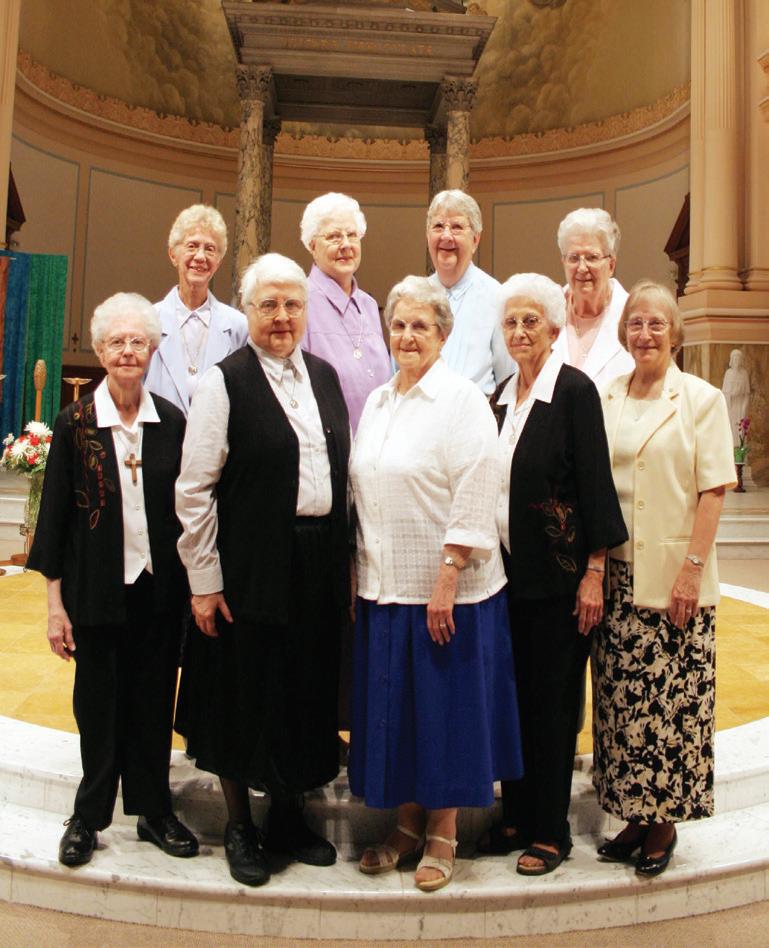

S. Patrice’s parents, Harriet and John Vales, had complementary traits they shared with her. She thinks of her mother as her spiritual director who taught S. Patrice to be prayerful and observe religious customs; for example, to create May altars during the month of May. She remembers her mother’s diagnosis of diabetes when she was in third grade. The custom in their parish was for the parents to receive Holy Communion with their children on First Communion day. Because of the diabetes, S. Patrice’s mother was not able to fast until after Communion; she was disappointed when the parish priest did not make an exception for her. Her father was very practical. S. Patrice liked to watch him repair things around the house. Throughout her life she has relied on those lessons when she fixes things rather than call on a repair person. She remembers fondly their happy family life. Sundays were special times for all of them to enjoy family activities.
S. Patrice had two younger siblings. Her sister, Florence, was 18 months younger, and the two have always been close. S. Florence wanted to be an SC like Patrice but was hesitant to leave her mother because of her diabetes, but her father encouraged her to go ahead. After the Second Vatican Council, S. Florence transferred to the Poor Clare Sisters in New Jersey, where she lives today.
S. Patrice’s brother, Robert, was born six years after her. He served in the U.S. Navy, then worked for the U.S. Postal Service until he married Sharon. They bought a dairy farm near Danville, Ohio, and reared their five children there. Bob died in 2017. Sharon remains in Danville and is involved with the bereavement committee of her parish, preparing meals for families.

S. Patrice attended Holy Name elementary and high schools in Cleveland, where she met the Sisters of Charity. She remembers always having an inkling that she might want to be one of them. She has particularly fond memories of S. Modesta Bain, her first grade teacher, whom she remembers as very kind. And two of her high school teachers stand out in her memory. S. Mary Bernice McGrath, her junior English Literature teacher, frequently quoted Shakespeare and the Bible. And S. Loretta Marie Auer, the music teacher, who stopped her on the playground one day and said, “I think you might have a vocation.” She encouraged S. Patrice to write a letter to the Mother General. Patrice asked S. Loretta Marie to be the one to write the letter, which Patrice signed and mailed – and the rest is history!

After high school, when it was time to go to Cincinnati, her parents and grandmother drove her. They arrived on Labor Day before Sept. 8, so her father would not miss days of work. S. Patrice told God she would stay for a month. By the end of that month she had forgotten about it, and had settled into the life of an SC postulant. S. Patrice remembers that S. Camilla Smith, the director, asked her which saint she liked. When S. Patrice named the Little Flower, S. Camilla gave her a biography to read. S. Patrice learned that the Little Flower had cried when she left home, as did Patrice. So she never read another book about the Little Flower!
S. Patrice laughs when she recalls a day when the postulants walked to the cemetery for a burial. She read the sign at the entrance, “Sisters of Charity.” That was her first realization of the name of the congregation – she had always thought it was Holy Name Sisters because they were the ones who taught her in elementary and high school!
When she received the habit, she was given her own name, Patrice, in memory of a recently deceased Sister. Receiving the habit and making vows were exciting moments for her.
S. Patrice’s first mission was Saint Anthony School in
18 INTERCOM
S. Patrice Vales (front row, right) celebrated her Diamond Jubilee with her Band members and the congregation in 2009.
Kenton, Ohio. The four school Sisters lived at San Antonio Hospital with the hospital Sisters. She recalls how grateful she was that S. Catherine Noreen Driscoll helped her plan the following week’s lessons every Wednesday. She needed to plan for two groups at once because each of the four classrooms had a double grade.
S. Patrice loved teaching the little children from first to fourth grades in Kenton and at St. Mary’s, Chillicothe, Ohio; St. John Baptist de la Salle, Chillum, Maryland; St. Gabriel, Glendale, Ohio; and St. Albert the Great, Dayton, Ohio. The younger students enjoyed listening to the stories that Patrice loved to tell.



After 15 years in the classroom at St. Albert the Great, she was asked to create a new position in the parish: pastoral minister. S. Patrice was happy to take this step to implement the spirit of Vatican II. She sought advice from people in other parishes, then recruited parishioners to serve in bereavement and RCIA programs, plan liturgies, visit people who were homebound or in hospitals, and work with the women’s Christ Renews His Parish weekends. The people responded eagerly to her invitations because they appreciated her service to the parish community during her years in the school. She served as pastoral minister in the parish for 15 years, until she celebrated her 75th birthday.
At that point S. Patrice and her cat moved to Cincinnati and Patrice began the next phase of her life and ministry. She tutored at Holy Family School, then S. Marty Dermody asked her to work in the Communications Office. After the COVID pandemic she began her service in the Archives, indexing and digitizing materials, and preparing pictures for



display in the Motherhouse corridors. She enjoys “floating” among different offices, running errands and delivering materials throughout the Motherhouse, greeting Sisters, employees and visitors along the way. She participates in the Earth Justice Circle, and invites all of us to reflect on the gift of Earth in her monthly Earth Day email messages.
S. Patrice observes that she finds herself more fulfilled and satisfied as the years go by. She counts her blessings daily, especially the awareness of God’s presence in her life, opportunities to watch basketball and the Cincinnati Reds, moments to read, relax and do crossword puzzles. And we all thank God for the blessing of S. Patrice among us.
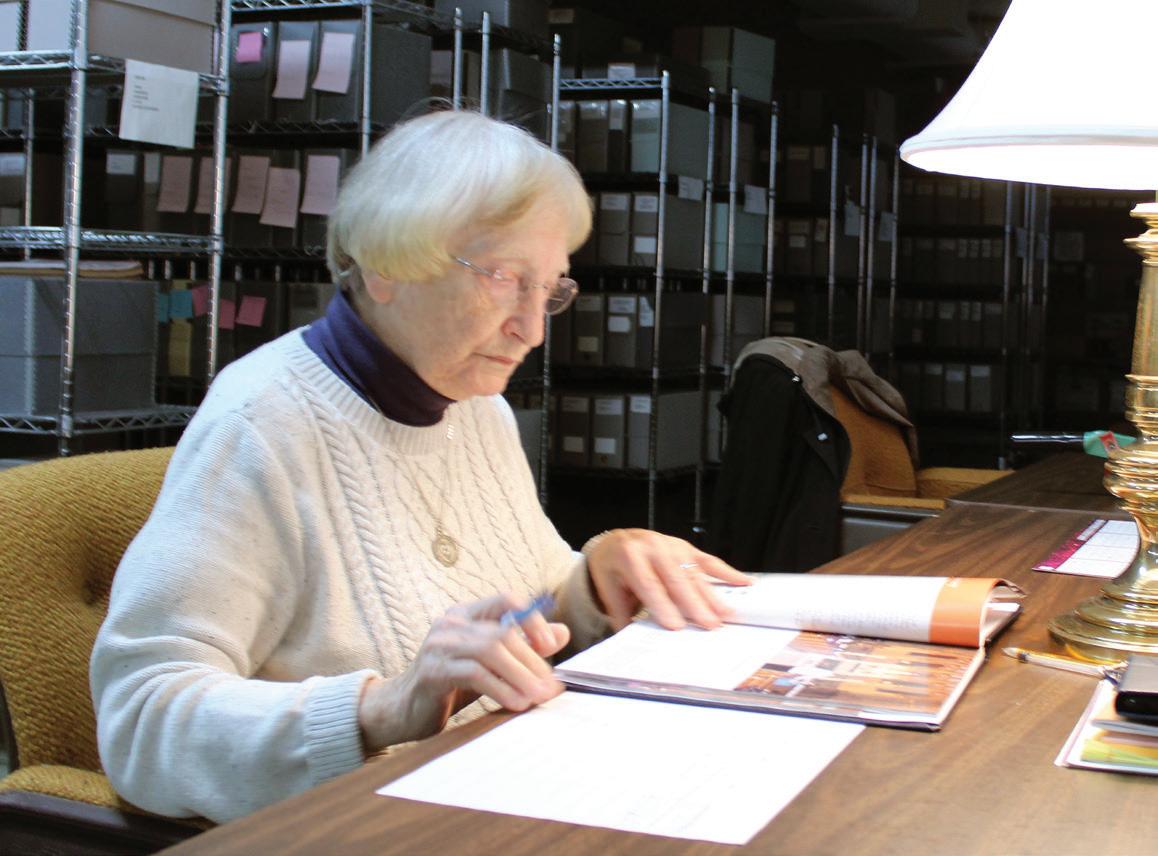




VOLUME I, 2024 19
S. Patrice Vales currently volunteers her time in the SC Archives indexing materials.
In her spare time, S. Patrice Vales enjoys reading and relaxing with her cat.
(From left) Sisters Florence and Patrice Vales both entered the Sisters of Charity of Cincinnati before S. Florence transferred to the Poor Clare Sisters in New Jersey.
Responding to the Emerging Moment
By Mackenzie Doyle, justice promoter
As we head into our second year of Justice Circles, there is much to be grateful for including the involvement of more than 80 Sisters, Associates, and community members. Here are some updates from the circles:
The Immigration and Ending Human Trafficking Justice Circle sponsored two movie showings in January of “Sansón and Me,” a documentary looking at one immigrant’s story. This film highlighted the intersection of immigration justice and criminal legal reform as Sansón has been sentenced to life in prison without the possibility of parole. This Justice Circle is also supporting an event at the end of April featuring Catholic Legal Immigration Network (CLINIC) executive director, Anna Gallagher, along with Elizabeth Clapp of Catholic Charities of Southwest Ohio.
Also in January, the Peace and Nonviolence Justice Circle invited Eli McCarthy, a professor of theology and justice and peace studies at Georgetown University, to come share about his experience of working with nonviolent activists in Ukraine. This was particularly powerful as many of us continue to mourn the loss of life in Gaza, Haiti, and numerous other conflicts around the world.
Locally, we, with many other religious communities in our area, are calling for an end to the violence in our local and national communities with a billboard that reads “Put the Guns Down! Nobody is Winning. Let Peace Begin with Me.” Posted near the Harrison Avenue exit, this is visible to cars heading south on I-75 and will be up from April 8 until May 5. Our sign will be duplicated in Dayton in June, possibly in Cleveland and Columbus too.
Another urgent matter that we need individual and collective action on is climate change. To show a way forward, the Poverty, Homelessness, and Food Insecurity Justice Circle and Earth Justice Circle co-sponsored an event in February that highlighted the intersectionality of food waste and food insecurity. This event featured Tony Staubach from Hamilton County Resource, who talked about the reality that 30 to 40 percent of the food produced is thrown away and how that impacts climate change. Eileen Budo spoke on behalf of Last Mile Food Rescue, a local organization trying to solve food insecurity in Hamilton County. Currently, one in five people go hungry, so Last Mile Food Rescue brings donated food to food pantries and shelters where people are in need of food. We are exploring ways we can contribute to Last Mile’s mission.
This winter, the Earth Justice Circle also finalized the Laudato Si’ Year Two Action Platform Commitments which can be found on our Earth Justice webpage and in this issue (page 29). They also provided us with Lenten reflections this spring. A few of their members are auditing a Beyond Plastics course, and we hope to have Beyond Plastics as a speaker event this year.

The United Nations NGO Justice Circle also focused on climate change this winter both before and after the Conference of Parties (COP) 28. This group next discussed the armed conflicts in Gaza and Haiti, and invited Fr. David Neuhaus, a Jesuit priest who has lived and worked in the Holy Land, for a clarifying conversation to help us better understand the complex and unjust situation today. We hope to continue discerning what is ours to do and say in this time.
The Racial Justice Circle has also launched a couple initiatives to keep the congregation focused on racial justice. This fall and winter, a couple groups met to discuss “The Spiritual Work of Racial Justice,” and in March, we started a small group that works through Sacred Ground, a readings and discussion-based program that reflects on the impact of racism on African, Asian, Latino, Native, and white Americans throughout history. That group filled up quickly, but a new group will start in June. Contact klears74@gmail.com to be added!
Lastly, in responding to the emerging moment, the Justice Circles invited Bridget Bearss, RSCJ, the LCWR associate director of transformative justice, to lead us in a reflective workshop in March to help us practice ways to be the authentic presence of peace during this election cycle in the U.S. and ongoing turbulence in our world.
20 INTERCOM
Making Changes for Our Earth
By S. Caroljean Willie
“From here, thousands of miles away, the Earth shows the incredible beauty of a magnificent blue and white pearl, floating in a vast, dark sky. It looks like it could fit into the palm of my hand. On it there is everything that is sacred and loved by us.” Edgar Mitchell
“From the moon, Earth is so small and so fragile, and such a precious little spot in the universe, that you can block it out with your thumb. Then you realize that on that spot, that little blue and white circle, is everything that means anything to you … and then you are changed forever.”
Rusty Schweigert

Earth – our home as seen by the astronauts challenges all of us to accept this most urgent task of cherishing and preserving it. In a nutshell: Earth’s human population as of Feb. 16, 2024, is 8.1 billion (UN). There are more than 8.7 million kinds of plant and animal species and scientists tell us that more than 80 percent of plant and animal species have yet to be identified; our planet is 29 percent land and 71 percent water. The single biggest threat to our home today is climate change and the single largest contributor to climate change is the action of humans. The lifestyle, particularly of those living in the more developed countries such as the United States, is simply not sustainable.
EarthConnection (EC) continues to provide multiple resources via webinars, in-person presentations for adults, students (K-university level), Girl Scouts and other organizations; our newsletter; and our website to inform and educate about Earth issues.
It is imperative that we educate ourselves about the realities of climate change. Fossil fuels, solid waste, leaking coolants and aerosol spray propellants are causing changes unprecedented in human history. Diets based heavily on meat consumption and processed foods have multiple negative effects on the environment. Why is meat consumption
bad for the environment? A few of the reasons include: 1) Directly or indirectly, the production of meat is related to deforestation in South America and the destruction of the forests disturbs the ecosystem and this causes a huge amount of CO2 emissions.
2) Biodiversity loss - the meat industry directly contributes to the extinction of thousands of species through deforestation. 3) Increased greenhouse gas emissionsanimals create a large amount of methane gas in the process of digesting their food. 4) Water usagemeat production uses a lot of water and beef is the most water-intensive food. Producing a pound of beef requires 2,500 gallons of water.
Signs of climate change can no longer be ignored. They are everywhere: changing rain and snow patterns, changes in animal migration and life cycles, less snow and ice, thawing permafrost, changes in plant life cycles, warmer oceans, rising sea levels, damaged corals, stronger storms, higher temperatures and heat waves and more droughts. Earth’s average land and ocean surface temperature in 2023 was 2.12 degrees F – the highest global temperature among all the years in National Oceanic and Atmospheric Administration’s 1850-2023 climate record.
At times the problems seem overwhelming and we ask, “What can one person do?” The most important thing is to take personal responsibility for your own choices and actions. Keep yourself informed. Join a local, state or national organization dedicated to environmental sustainability. Be willing to make changes in your own lives. Eat less meat, make choices that will decrease your use of fossil fuels, recognize that you are part of a global community and what you do does make a difference. For more ideas and suggestions check out EarthConnection’s website at www.scearthconnection.org.
VOLUME I, 2024 21
A Journey Into the Unknown
By S. Regina Kusnir
The image of the Holy Family engenders feelings of warmth, innocence and the willingness to journey into the unknown, trusting Divine Mystery. Little did S. Peggy Rein know what lay ahead of her when she was first assigned to Holy Family School in Cincinnati, Ohio, some 34 years ago.
S. Peggy started her ministry at Holy Family as a teacher of children in fourth, fifth and sixth grades. After five years, she was asked to teach eighth grade science. When the school needed a certified religion teacher, S. Peggy shared faith with kindergarteners and students in other grades. Presently, she teaches reading to kindergarteners. There she relishes working with groups of six where the impact of learning is obvious. She also teaches third grade religion, helps teachers plan Masses, preps readers for Mass and enjoys playground duty. The variety in her ministry is life-giving and she quips that, “When I’m not willing to try new ideas, I’ll retire.”
Holy Family lives up to its name. The student populace today is immigrant, primarily from Guatemala. A very supportive faculty joins together in caring deeply for the children. Each child is special, called by name, loved, cared for, and respected as unique. This is not the first contact with families from other countries for S. Peggy, who in the 1970s worked with migrants in Bay City, Michigan, as well as Union City and Findlay, Ohio.
S. Peggy witnesses strong ties in these immigrant families. For example, “a family came to Cincinnati in 2015. Years later


another family came to stay with them since there is always room for one more. This helps with their inculturation,” she says.
The parents are deeply committed to wanting their children to have the best education. They will sacrifice to see it happen by attending meetings, helping with projects, etc. The voucher program has helped families find educational stability.
Still there are challenges. Many struggle financially and tend to be underemployed. Some are “cleaners” to provide for their families leading children to accept responsibility for each other. Most children enjoy the free breakfast and lunch program and benefit from weekend food bags. “One child was asked what he would like for Christmas. His reply, ‘a bed,’” S. Peggy recalled.
Parents are deeply religious and Holy Family’s Sunday Spanish Mass is lively. The cultural contributions of these families include soccer, “the big sport,” and festivals with the music, food, and dance of the Guatemalan community. The delightful, animated, lovable children “always give you a hug,” she says. “If I can help these children get a good education, I am witnessing the works of mercy.”
Two quotes from St. Elizabeth Ann Seton inspire the ministry S. Peggy loves: “God takes delight in his people,” and, “If this project is to succeed, praise God. If it does not succeed, praise God because it wasn’t supposed to.”
22 INTERCOM
S. Peggy Rein has ministered at Holy Family School in Cincinnati since 1991 and currently teaches reading to kindergarteners in small groups.
S. Peggy Rein teaches third grade religion at Holy Family School in Cincinnati, Ohio.
Admirable Assistance
By Katelyn Rieder, Communications co-op
While living in Indianapolis, Indiana, in the 1990s and early 2000s, S. Pat Wittberg became involved with the Society of St. Vincent de Paul (SVDP) through her local parish. The goal of the organization is to give back and help others through local initiatives, such as food pantries and thrift stores. S. Pat’s involvement was with home visits, which aim to assist people with resources like furniture, clothing, and more.
When she moved to Cincinnati, Ohio, in 2015, S. Pat’s home parish, Holy Family, was looking to expand their branch of St. Vincent de Paul beyond its food pantry. A few years later in December 2019, Fr. Len Wenke (former pastor) and several other parishioners worked together to start up their home visits program. Holy Family parish is a smaller community located in East Price Hill. “Some of the larger suburban parishes have maybe 15 to 20 people in their St. Vincent de Paul Society,” S. Pat explained. “We have about seven or eight.” The lack of volunteers would become one of several challenges the group faced.
Not long after they officially started home visits, a major fire occurred a few blocks from the church. This displaced several Guatemalan families, which S. Pat referred to as the backbone of Holy Family. In the following months, the COVID-19 pandemic struck, resulting in a frantic time for the community as a whole.
Instead of leaving when faced with these obstacles, S. Pat stayed committed. “I’m growing a lot because of my ministry. You have to have something draw you out of yourself so that you keep on growing.”
During home visits, S. Pat is able to meet many people in need of assistance. While there are some that try to take
advantage of the system, there are also others that are simply delighted that someone is there to help. Over the years she has ministered with SVDP, S. Pat has met numerous families and individuals with various needs or issues: a couple that can no longer work due to health issues; a divorced immigrant woman; a man who struggles with addiction. There are countless people who reach out to St. Vincent de Paul, and S. Pat does everything she can to help by providing resources directly, or connecting them with other organizations.
She reflected, “I keep thinking to myself that it’s got to be God, because what would have happened to any of these people if we didn’t show up?”
Many of the people who S. Pat helps are immigrants. For many years now, people from other countries have fled to America, Europe, etc., seeking asylum. “I would say to anybody that if you hear the stories about why they’re coming here, and if you were in that situation, you’d be here too,” said S. Pat. “We’re honored to have them here, but we also cannot handle the amount that’s crossing the border currently, we just can’t.”
“The whole system is a mess,” she continues. “You cross the border, you ask for asylum, and in three years they might accept you. It’s just terrible and we need to do something, preferably to help them in their own country.” By advocating for change in these war-torn countries, S. Pat believes we could see real change.
To do this daily, she suggests we “politely challenge the narrative” about immigrants. “I know people who believe that they’re all drug smugglers and they all need to be sent back tomorrow. To them, you can say, ‘That’s not my experience.’” She also suggests that people volunteer or donate to organizations like St. Vincent de Paul that work with immigrants.
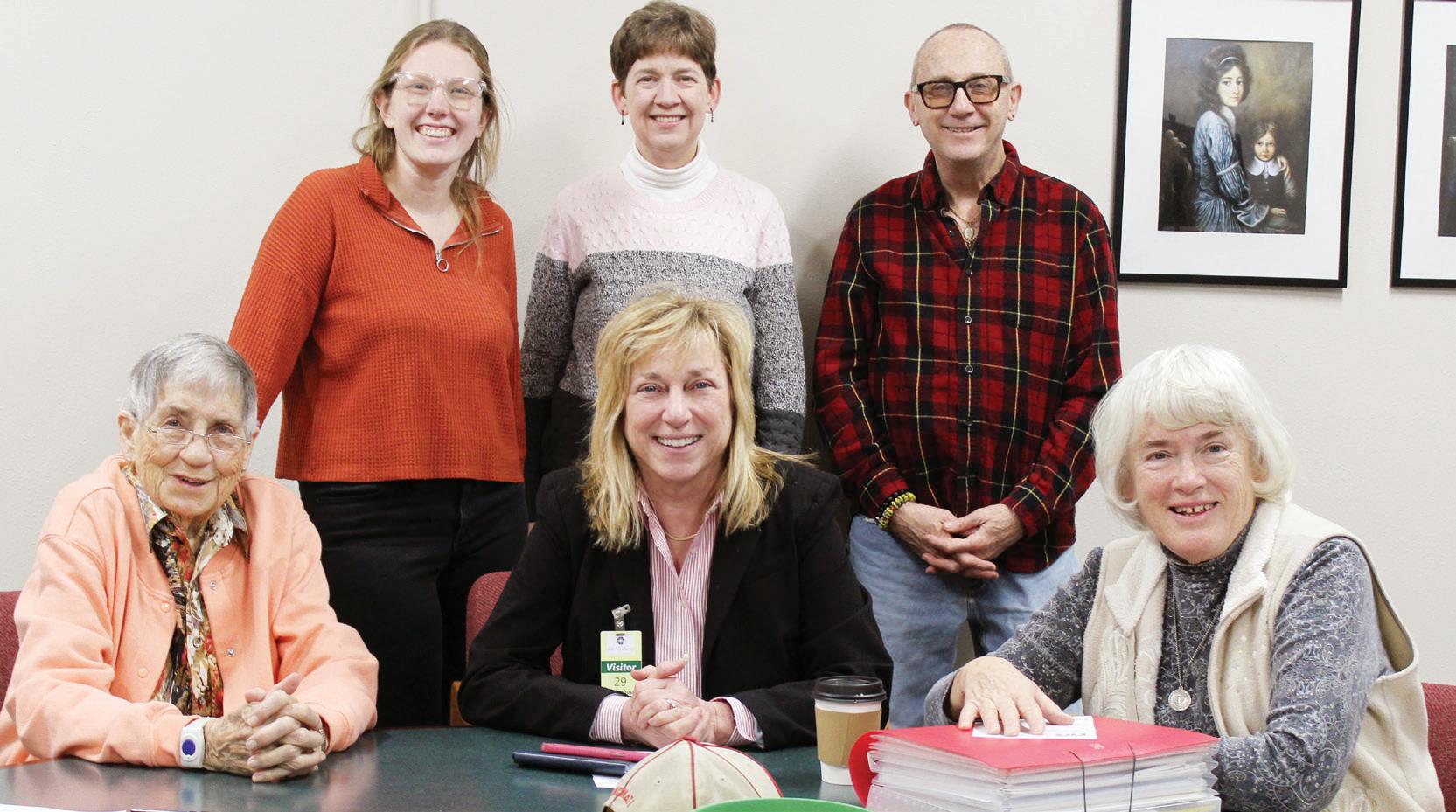
“We need these people. We can’t lock them out—we need them for our economy and we need to help them,” she concludes. “We need to figure out a way to get people in and help them at a volume we can handle. Somebody needs to stand up and say that.”
Members of the St. William parish St. Vincent de Paul conference welcomed Olivia Scheper (back row, left), a staff member from the downtown SVDP office, to a recent meeting. Also pictured (front row, from left) S. Shirley Le Blanc, Robbie Jennings Michels, S. Pat Wittberg, (back row, middle to right) Dee Besl and Victor Fabro.
23 VOLUME I, 2024
An Unexpected Journey
By Associate Angela Anno
“Fan of FutureChurch ... survivor believer ... Black Lives Matter adherent ... mom ... grandma ... sister ... aunt ... activist ... fierce defender of my sisters around the world ... political junkie ... art lover ... roller skater ... lover of red zinnias ... kickball champion ... friend of orange monarch butterflies ... seeker of stories ... ever curious amateur ... God’s Vanna White ... pointing to Her dream for the world She loves ...” That’s how Associate Deborah Rose describes herself today in the signature line on her emails.
A writer for the National Catholic Reporter (NCR) calls Deb “a woman of spunk, spirit, and hope.”
“But that confidence didn’t magically appear,” she responded. It was born from her “personal struggle to grow and mature as a Catholic woman.”
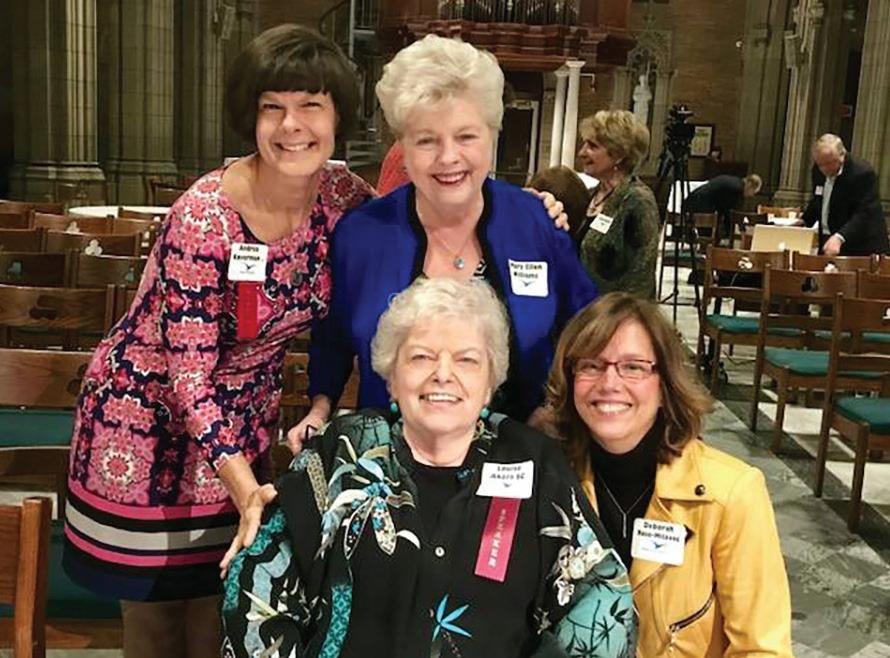
When she was growing up in a small town in Shelby County, Ohio, Deb never could have imagined the path her life would take. Her parents were devout Catholics, her faith was part of her everyday life, and options for women were very limited. At that time it was understood that her two brothers would go to college, but girls didn’t need further education, so she and her sister would marry and have children. She did just that—married young and had five children and continued being active in her church. At one point a deacon who was teaching adult education nearby suggested that she go back to school. She did go back earning a degree in international studies and a master’s in theology. She describes these times of raising children and learning as “gifts in my life.”
Like parenting and going to school, each new job she accepted opened doors and enlarged her vision of what she was called to do. One of her first jobs after getting her master’s was as director of a domestic violence center in Shelby County, where she did a lot of community advocacy work, provided wrap-around services and helped women understand they were not responsible for their abuse though they often were blamed for it.

During the Iraq War she worked with a Quaker group, organizing people for peace. Later, in Hamilton County, she worked for an organization that provided programs for underserved youth. She was also active with Nuns on the Bus as they advocated for justice and social change.
Through groups like Women Writing for a Change, she gained a deeper understanding of women’s pain of being excluded from “educational and ministerial opportunities available to men.” She saw so many women leave the Catholic Church to follow their calling. She said that while she was glad to see them follow their call, she was also sad to see such a “faith and gift drain” in the Catholic Church.
This led her to work with Catherine of Siena College in England with their online program to reach out to women in developing countries and provide them with up-to-date religious studies including feminist theology. She traveled to India, China, South Africa, Kenya, Namibia, Sri Lanka, and other regions, to spread the word about the program that empowered women.
Mission trips to Honduras changed her life in substantial ways. Dr. Mike Gable of the Archdiocesan Mission Office who guided the trip, also introduced her to Sister of Charity Louise Akers. S. Louise transformed Deborah’s understanding of “the prophetic nature of women religious who pioneered
24 INTERCOM
Deborah Rose retired as the executive director of FutureChurch in December 2023 after serving in the position for 10 years.
Associate Deborah Rose (front, right) developed a deep and lasting friendship with the late S. Louise Akers (front, left).
so many ministries to the forgotten and marginalized, worked to educate those who lacked access, struggled against poverty and violence and helped build the kingdom of God.” The two developed a deep friendship and, in time, S. Louise invited her to become an Associate and served as her mentor. Deborah shared, “S. Louise Akers’ spirit is forever emblazoned in my heart. I will never forget our many talks and the many, many laughs we had together. And now, when I face struggles or difficulties in my work, I ask myself, ‘What would Louise do (WWLD)?’”
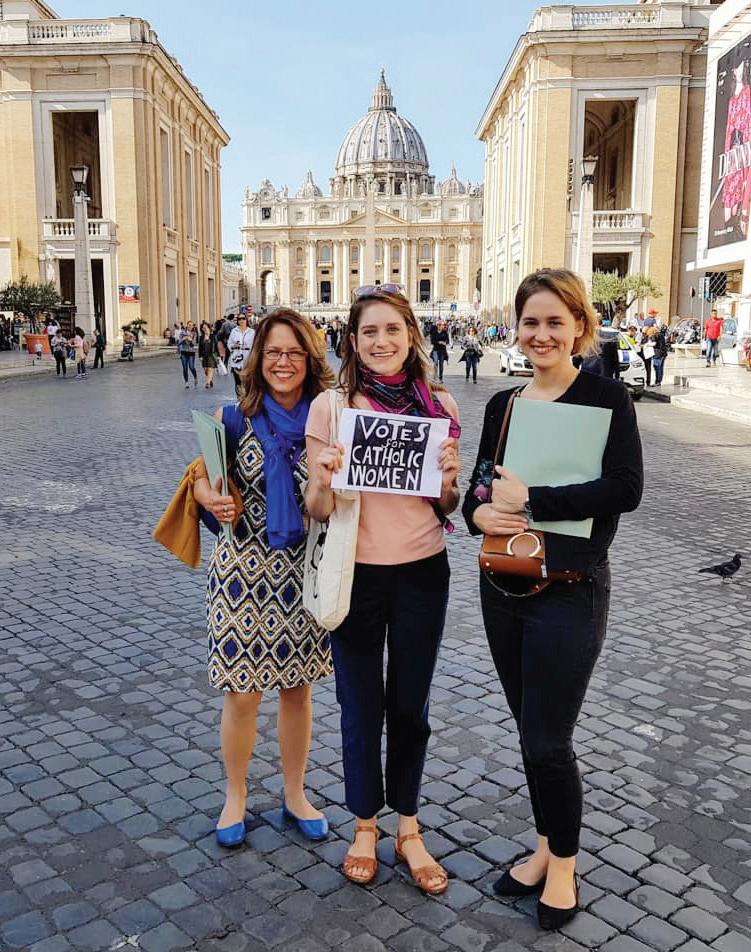
When FutureChurch, an organization that “seeks changes that provide all Roman Catholics the opportunity to participate fully in church life and leadership,” was seeking a new executive director, Deborah applied and got the job. That was 10 years ago. She retired at the end of December.
Though she believes there’s still much work to do, Deborah sees that Pope Francis’ strong interest in opening doors in the Catholic Church for women and his inclusion of women as voting members of the Synod, the Curia, and heads of Church offices as crucial steps toward positive change.
One area where there has been a lot of work is in recovering the stories of women in the Bible. Deborah explained that “though Mary Magdalene’s memorial has been upgraded to a feast, on Easter Sunday, the lectionary still fails to include the complete reading of her encounter with Jesus, and her courageous proclamation of the Resurrection to the brothers and sisters. Even though she was named ‘apostle to the apostles’ in 2016 by Pope Francis, her sharing the Good News of his resurrection with the disciples is not heard on the highest-ranking holy day of the year.”
During the 2019 Synod for the Amazon, Deborah helped project images of a “Votes for Catholic Women” sign around Vatican City. This past fall, women voted in a Synod of Bishops for the first time. According to the National Catholic Reporter (NCR), “colleagues said the persistence, collaboration, creativity and passion she brought to the ‘Votes for Catholic Women’ campaign are qualities emblematic of her past decade at FutureChurch.” She celebrates the fact that 54 women cast votes at the Synod.
Her coworkers describe her as “a brilliant combination of spirit and spunk and a serious work ethic to advance the Church as well as being fun to work with,” the NCR reported. “Deb infuses joy into the struggle — joyful resistance along
with prophetic persistence.” Under her leadership, FutureChurch helped advocate for greater participation in the synods, created online programming that spotlights biblical, historical and contemporary women, and founded the award-winning Catholic Women Preach project which produces regular reflections on scripture from women around the world and gives Catholics an opportunity “to hear women’s wisdom, their challenges, the way they see faith.”
Through FutureChurch educational resources, many Catholics have learned that “the early Church functioned very differently from the Church today,” Deborah said. “Women, like Mary Magdalene and others, walked alongside Jesus, Paul, and the other men and women as co-equals. And because our Church has developed without the full participation of women, Catholics often leave and the flock is being scattered.”
“That is distressing,” said Deborah, “because the Catholic Church needs these faith-filled, gifted, and brilliant women more than ever as we face seemingly insurmountable problems in this complicated, polarized, individualistic world.”
Yet, in her decade at FutureChurch, Deborah believes that more women and their allies who love the Church have newfound hope. “They’re working for change and not giving up. That infuses me with hope and joy and nourishes my spirit,” said Deb.
She believes strongly that Pope Francis’ determination to create a more synodal Church where people of faith walk together, prayerfully listen to each other, and discern together will transform the Church. “A Church that can listen with heart to those who have been excluded is a Church that can learn to live the Gospel more fully.” She believes.
What’s next for Deborah? Catholic Social Teaching has had a strong impact on her and she plans to put her energies into work to decrease gun violence. She’s already joined “Nuns Against Gun Violence” and “Moms Demand Action.”
In February 2024, the board of FutureChurch voted to make Deborah “Emerita” and she will serve as a consultant for important projects, like “Mary Magdalene Goes to the Synod” where FutureChurch will continue its decades-long effort to expand the lectionary so that the stories of our foremothers in faith, like Mary Magdalene, Phoebe, Shiprah, Puah and more, can be proclaimed more faithfully on Sundays, holy days, and throughout the year. She also plans to savor time with her children and 21 grandchildren.
VOLUME I, 2024 25
During the 2019 Synod for the Amazon, Deborah Rose (left) helped project images of a “Votes for Catholic Women” sign around Vatican City.
Sharing Wisdom and Culture
By S. Georgia Kitt
When making a special trip, one deems it a success when you can look back and say, I made wonderful friends, brought back new energy to my work, embraced new cultures, contributed new insights to colleagues and made lasting memories. This could surely be S. Alice Ann O’Neill’s assessment of her October 2023 trip to Japan, the birthplace of Dr. Shinichi Suzuki and the teaching method she shares with her students in her Cincinnati Cello School at La Casa del Sol Ministry Center.
Twenty-five years after her first visit to Japan, S. Alice Ann returned for the Third International Suzuki Teacher Training Convention, joining colleagues Colleen Fitzgerald, violinist from Milwaukee, Wisconsin, and Stephanie Hunt, cellist from St. Louis, Missouri. The three had planned to arrive a few days ahead of the convention to visit Tokyo and the Royal Palace, Asakusa and the Main Temple, before taking the four-hour train trip to Matsumoto where the convention took place. S. Alice Ann would say they found travel videos on the app TikTok most helpful as they navigated the subway system, trains and walked 25,000 steps per day in Japan. “We checked it out before going which was an invaluable guide,” she said. “It helps if you demonstrate a willingness to learn. While there I had the best sushi ever and loved being immersed in the culture.” She was particularly struck by the beauty of the people and the culture as well as the broad use of technology.
The convention for Suzuki teacher trainers from across the world met in the Japanese Alps near Matsumoto, the birthplace of Dr. Shinichi Suzuki, where he lived and taught, nurtured by love. They walked the grounds and visited Matsumoto castle as well as his grave. S. Alice Ann was invited to give a talk to her colleagues gathered. Entitled “Suzuki Wisdom: 2023 and Beyond,” she revisited the fundamentals of the teaching method and encouraged greater flexibility, applying lessons learned through the pandemic. Dr. Suzuki encouraged teachers to try a new idea every day. S. Alice Ann believes that introducing students to the method at an earlier age allows the pacing rate through the prescribed teaching books to move faster and the students to achieve more sooner. This has definitely been true in her own teaching experience.
Looking back on the trip, S. Alice Ann would say that efforts to reach international unity through an equalizing of the teacher training has made some progress. More teacher trainers plan to try online teaching which has been slow to be implemented worldwide. Greater efforts toward affiliation through an association will hopefully be on the agenda in the upcoming area meeting in Louisville, Kentucky, this spring. Enjoy the accompanying photo highlights.



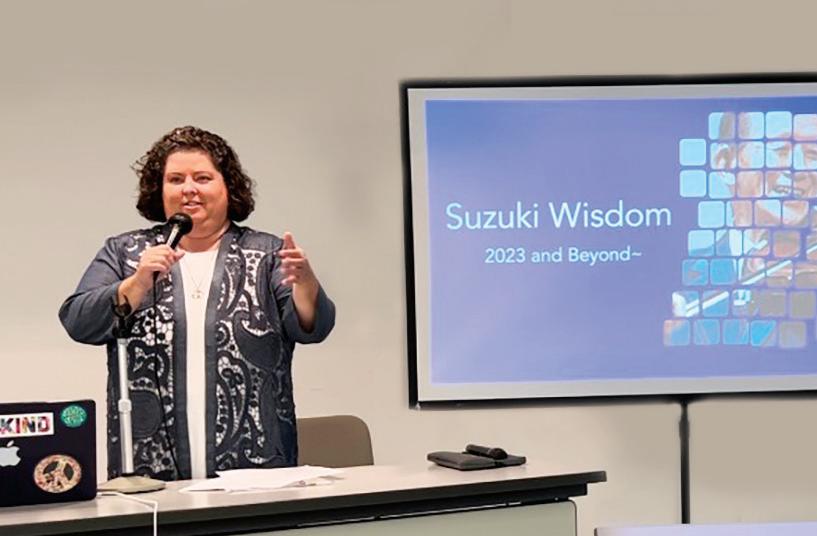
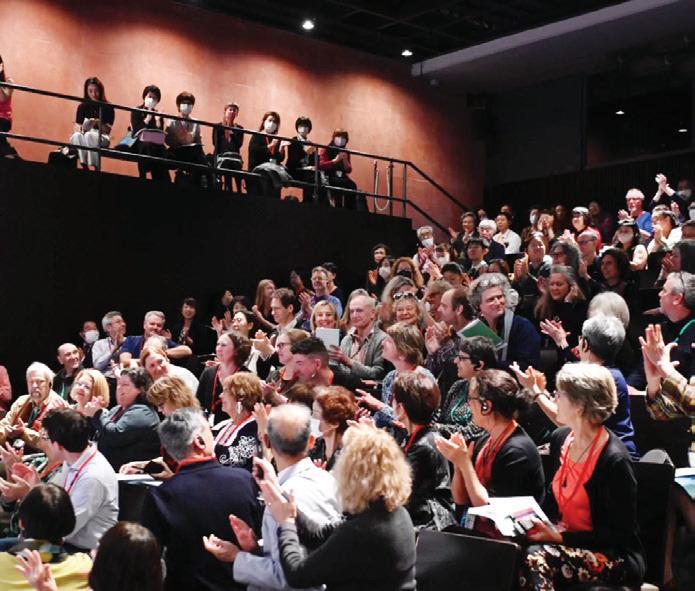
INTERCOM
26
Drumming with Love
By Katelyn Rieder, communications co-op
From a young age, S. Shirley Le Blanc has experienced a love for drumming. Even though her family encouraged her to pursue other quieter instruments, she held the interest until she finished school and bought her first snare drum.
With that first drum, S. Shirley started to play whenever and wherever she could. She recalled, “I didn’t want to play in a band or anything, I just liked having fun.” Her passion became noticed and appreciated by others as she played during Sunday masses and services at her local church. That first snare drum has stayed with S. Shirley all throughout the years, and now allows her to play with others in the Sisters of Charity Drum Circle.
Back in 2016, S. Shirley was approached by S. Caroljean (Cj) Willie to lead a Sisters of Charity Drum Circle, thinking it would be a worthwhile and fun endeavor. After S. Shirley agreed, S. Cj allowed her to take the reins on the project. After a bit of planning, the very first meeting was a tremendous success and surprised S. Shirley greatly; more than 25 Sisters, Associates, employees, and others showed up ready to drum.
“Naturally, I didn’t have any other drums except my own personal drums, but I knew that I wanted to do this,” said S. Shirley. During this beginning stage, participants drummed on painted upside-down plastic buckets with homemade mallets (dowels with rubber toy balls tied together with felt). Since that first meeting nearly eight years ago, the Drum Circle has expanded and improved to now provide everyone with their own real drum and sticks for the hour. There is currently a Drum Circle gathering once a month in both Mother Margaret Hall and in the Motherhouse’s Cedars Auditorium.
Within the “hour of fun,” as S. Shirley lovingly calls it, a CD of curated music and songs plays for participants to drum along to. There are no rules or requirements—everyone is encouraged to play from their heart.
“With the elderly, they’re not usually there to soul search and get into meditative drumming,” S. Shirley expressed, “they just want to have fun and express
themselves with their hearts and their drums. It’s just absolutely wonderful to see and to be a part of.”
To contribute to the welcoming atmosphere, S. Shirley does her best to bring a variety of music genres for the group to play along to. From the blues to traditional marching band songs, everybody’s requests are met at some point in the hour.
An unexpected result of her facilitation is all the friends and resources she has connected with throughout the years. “If somebody ever comes across a drum they won’t use, they know they can give it to us,” said S. Shirley, laughing.
One of the many connections made through the Drum Circle was with the well-celebrated Royal Drummers of Burundi, who visited and performed at the Sisters of Charity campus in November 2023. It was a once-in-a-lifetime experience for all who attended.
Drumming has always provided S. Shirley with a sense of comfort, and this is only amplified when playing with others. She reflected, “As you get older, you change and you want to do more for people who are hungering for some spiritual connection with another person. So you extend your kindness and charity to them, and it creates a whole new connection for them.
“I think my motto is I do things because I can, and I probably will until the day I die,” she continued. “[Facilitating the Drum Circle] is a big motivator for me and a good practice in gratitude and trust; it helps me put more of my trust in God.”


VOLUME I, 2024 27
S. Shirley Le Blanc leads the Sisters of Charity Drum Circle monthly in both Mother Margaret Hall and the Motherhouse.
The Royal Drummers of Burundi visited and performed at the Sisters of Charity campus in November 2023.
A Joyful Presence
By Erin Reder
Astroll through the halls of Romero Academy at Resurrection in Price Hill (Cincinnati, Ohio) will quickly reveal the influence S. Juliette Sabo has on the students and staff. Hugs, well wishes and kindnesses are in abundance as she makes her way from one end of the school to the other.
S. Juliette, who ministered as an elementary educator at Resurrection School from 1996 until 2020, chose to return to the school after Romero Academies assumed management the following school year. Prior to the transition, the school at Resurrection parish had been losing money, enrollment was down and it was planning to close permanently. S. Juliette had faith in a burgeoning partnership between Seton Education Partners, the Archdiocese of Cincinnati and Catholic Inner-City Schools Education Fund and knew that with committed teachers and staff, students would continue to receive excellent instruction.

Sister in the school or the classroom, her presence provides emotional and spiritual support. Catholic values are at the center of all that Romero Academy does. S. Juliette, with her positive disposition, affirmations, and respect for all, builds morale and confidence in the students and staff. Her presence is a guiding light for those she encounters.
The school model at Romero Academy is based on a belief that success is more than academics; it’s about character, faith formation, partnership and how the content is taught. Romero focuses on five key areas: character building education, Catholic values, high expectations, partnership, and personalized learning.
It’s in these personalized learning experiences that S. Juliette is called on. Teachers at Romero instruct in groups of 10-15 students. This blended learning model allows students to receive “just right” instruction that adjusts to the unique needs of the student. S. Juliette is an aide in the second grade and works in small groups or individual situations to help the students learn at their own pace. Her assistance enables the teacher to maximize the amount of time an adult can work with a student.
Sister volunteers at the school three days a week and mostly helps students with their reading and math skills. She says she most enjoys seeing the progression they make, especially those with difficult struggles inside and outside the classroom. “You don’t know the circumstances that they are coming from,” she says. “They keep trying and you can see how loving they are.”
More importantly, and what is visible to anyone observing
Resurrection School was long known as a school that ministered to the underserved and welcomed newcomers to this country. This tradition continues at Romero, and S. Juliette is pleased to see that even though the school has changed, the core values remain. She appreciates the opportunity to help and model acceptance in any way she can. “Immigrant children have an appreciation for learning and for one another,” she remarks. “They take care of each other, and stick together. … I would say in order to help families thrive and maximize their full potentials, it is important that when we are aware of problems, to discreetly help. Don’t make a big deal about it; just help as you can.”
Success at Romero Academy is defined as more than academics. S. Juliette, with her focus on love, joy and the dignity of all, plays a most important role in enabling students to thrive not just academically but in all facets of their lives.
As school principal John Lane emphasizes, “She brings a smile in the hallway. Everyone knows S. Juliette. All the students love her. She is a presence of the charism of the Sisters.”

28 INTERCOM
S. Juliette Sabo volunteers as a second grade aide at Romero Academy at Resurrection in Price Hill (Cincinnati).
S. Juliette Sabo works in small groups or individual situations to help the second graders at Romero Academy at Resurrection learn at their own pace.
Care for Our Common Home
As a congregation, we, the Sisters of Charity of Cincinnati, embrace the Laudato Si’ Action Platform and commit to journey together towards ecological conversion. We recognize that we have entered a new age, one which thrusts us into a new relationship with God and with the community of all of creation. This new understanding, this new sense of communion with planet Earth, has entered our minds and hearts. Reading the signs of the times, we see the intersectionality of the devastation of Earth, poverty, racism, migration and other social injustices.
In November 2020, a two-year visioning process began to gather data from Sisters, Associates, community partners (locally and nationally), and younger religious. It was determined that the most effective means of addressing justice issues was to call forth those injustices which Community members were most passionate about and create Justice Circles, self-organizing groups of Sisters, Associates, colleagues and collaborators who regularly come together around a focused issue. Over the past year, six Justice Circles have formed: Earth Justice; Peace and Nonviolence; United Nations NGO Impact; Poverty, Homelessness and Food Insecurity; Immigration and Ending Human Trafficking; and Racial Justice.

Actions
• Reduce meat consumption; provide input on the reasons why to do so.
o Reflect about the experience; discuss the spirituality of this initiative.
o Provide examples about our experience (short) – what it’s like in community.
o Share recipes for meat-free meals; take advantage of Catholic Climate Covenant which offers a new recipe every Monday (https:// catholicclimatecovenant.org/?s=meatless +Monday+recipes).
• Reduce single-use plastic.
• Provide monthly updates on our LSAP commitments.
• Continue increasing recycling efforts.
o Through education about the percentage of items actually recycled; e.g. plastic bags (less than 10 percent are actually recycled).
o Explore items The Cincinnati Recycle and Reuse Hub accepts; they guarantee items are recycled.
Advocacy
• Write letters to the editor in regard to climate actions.
Recognizing the intersectionality among all of the Justice Circles and priority issues, the Community chose climate change and the effect it is having on all of the issues as the basis for our Laudato Si’ Action Commitments in year two.
Laudato Si’ Action Platform Commitments for Year Two
Education
• Provide a series of films on environmental issues both in-person at our Motherhouse and retirement center and via Zoom.
• Invite speakers to educate ourselves about initiatives in which we can participate on the following topics: food waste, single-use plastic, human trafficking, and environmental racism, among others.
• Provide webinars through EarthConnection, our environmental center, on environmental sustainability; e.g. Laudato Deum, Laudato Si’, climate change, migration and poverty, among others.
• Learn how food systems (agriculture, nutrition, crops, and waste) affect climate change.
• Write to local, state and national legislators to promote legislation regarding climate change initiatives; e.g. eliminating plastic bags, supporting bills that address clean water, pollution, etc.
Network
• With other religious congregations
• With parishes
• With local civic entities (e.g. Delhi Township)
• With other justice groups (e.g. Ohio Sisters Justice Network, Network, local and state environmental organizations)
• Work with local entities knowledgeable about agriculture.
Ecospirituality
• Continue to deepen our understanding of ecospirituality through presentations, movies, and prayer.
• Provide photo reflections on Laudato Si’ for Advent, Lent and the Season of Creation.
• Provide reflection sheets on LSAP Goals and our SC Charism/Vision statements.
VOLUME I, 2024 29
Retracing the Steps of Blandina
By S. Georgia Kitt
It will be 10 years this June 2024 since the board of CHI
St. Joseph’s Children’s Hospital, Albuquerque, New Mexico, and the Catholic people of New Mexico first went to Rome to request that Sister of Charity Blandina Segale be considered for sainthood. For the board December 2023 seemed a fitting time to share the experience of a pilgrimage and retreat to Italy to promote Servant of God S. Blandina’s cause for beatification and canonization. This trip offered the board members a shared experience, connecting them with the deep traditions of the faith. As the co-petitioners of S. Blandina’s cause, they brought with them their passion for the mission, appreciating the continuous spiritual thread apparent in the places they visited throughout Italy.
As pilgrims, the group of 21 current and past board members, brought the spirit of S. Blandina with them. In Assisi visiting the Basilica of St. Francis they took time for a retreat, reflecting on S. Blandina’s life and call while highlighting the prayer for her canonization. As they stood in St. Peter’s Square for the Angelus Prayer with Pope Francis providing a reflection on the Gospel of the day and as they toured the basilicas of St. Mary Major, St. John Lateran, the catacombs and the colosseum, they prayed portions of the novena at each site.
Allen Sanchez, petitioner for S. Blandina’s cause and CEO for CHI St. Joseph’s Children’s Hospital, was moved by the concern members showed. “We walked seven miles each day, much of it on cobblestones, and even though we had both frail and able folks among us, a spirit of community emerged. So much respect was evident throughout.”


One of the newer board members, S. Annie Klapheke, says what stays with her from the experience is the relationships the group formed. “The members feel called to this work and participating in the deep, rich Church tradition together reconfirmed for us our call to love and service.”
S. Annie observed the members drawing parallels with their own faith traditions, giving evidence of their openness to learning and finding personal growth in their own faith life.
Diversity is a welcome quality which the board members bring and is also representative of the variety of clients that CHI St. Joseph’s Children’s serves, largely first-time parents and their young children’s needs found throughout rural New Mexico. The broad spectrum of spirituality the board members bring includes Catholic, Mennonite, Methodist, Jewish and Indigenous Heritage individuals along with those following Buddhism. They mirror S. Blandina’s spirit where all are welcome, all are deserving. She related to a wide range of individuals advocating for health care, education and immigrant rights. She valued her circle of associates and always invited them into her life of generous service.
S. Peggy Deneweth was grateful for the prime seats members had for the audience with Pope Francis. “Our purpose was to offer a gentle reminder of S. Blandina’s cause. It was so special that Elena Aguilar from our board and a member of the San Ildefonso Pueblo in Albuquerque was able to hand the pope a copy of S. Blandina’s novena. Elena was wearing her traditional Native American attire.” The encounter was a testament to the resilience and dedication of the CHI St. Joseph’s Children’s board, being true to their mission. S. Peggy was also honored to participate in the
30 INTERCOM
CHI St. Joseph’s Children’s Board member Elena Aguilar hands Pope Francis a copy of S. Blandina Segale’s novena during a pilgrimage in December 2023.
delivery of the official documents (Acts on the Life and Virtues of the Servant of God Blandina Segale) to the Dicastery for the Causes of Saints at the Vatican in December 2015. “S. Blandina’s life continues to speak to me,” she commented.
Being it was her first time in Italy, current board president S. Andrea Koverman found the pilgrimage and retreat days to be a fitting tribute to the faith. “It was as if I was struck dumb with awe,” she shared, “visiting so many sacred places. The scale of the art and beautiful mosaics was amazing. It is not abstract anymore. I now feel like I have a place in that long lineage.” S. Andrea was grateful to belong to this group and to be experiencing all of this together. The leisurely meals shared as a group, Italian style, offered them time to deepen their connection to S. Blandina, develop friendships and bond through prayer.
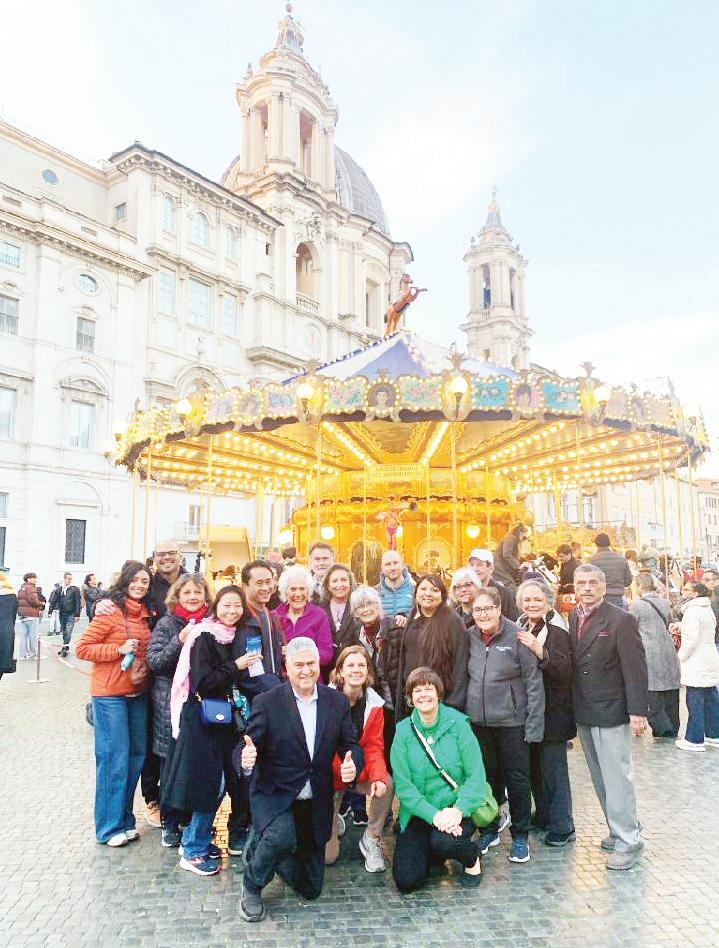
Reflecting on the experience, the board members felt honored to retrace the steps that S. Blandina took in 1950 when she herself, at age 81, went to Rome to petition for the cause for beatification and canonization of St. Elizabeth Seton. This pilgrimage served as an opportunity for the group to reflect, pray and recommit to the values exemplified by the Servant of God. They remain dedicated in their belief that great things can be achieved through S. Blandina’s intercession in the work of CHI St. Joseph’s Children and beyond.
As prayers continue for S. Blandina’s canonization and desired sainthood, it is good to be reminded that S. Blandina’s cause remains in the hands of the Church’s Historical and Theological commissions in Rome. Both the postulator and relater for her cause reside and work in Rome, available if needed for consultation. Forty-five miracles attributed to S. Blandina have been reviewed and are included in her file. To help further her cause, please continue to pray the novena to S. Blandina for healing needs, join others as they seek healing and recite the prayer for her canonization. All materials related to Servant of God S. Blandina Segale’s cause and life can be found on the Sisters of Charity website at www.srcharitycinti.org/who-we-are/archives/historical-resources/servant-of-god-blandina-segale-sc/.
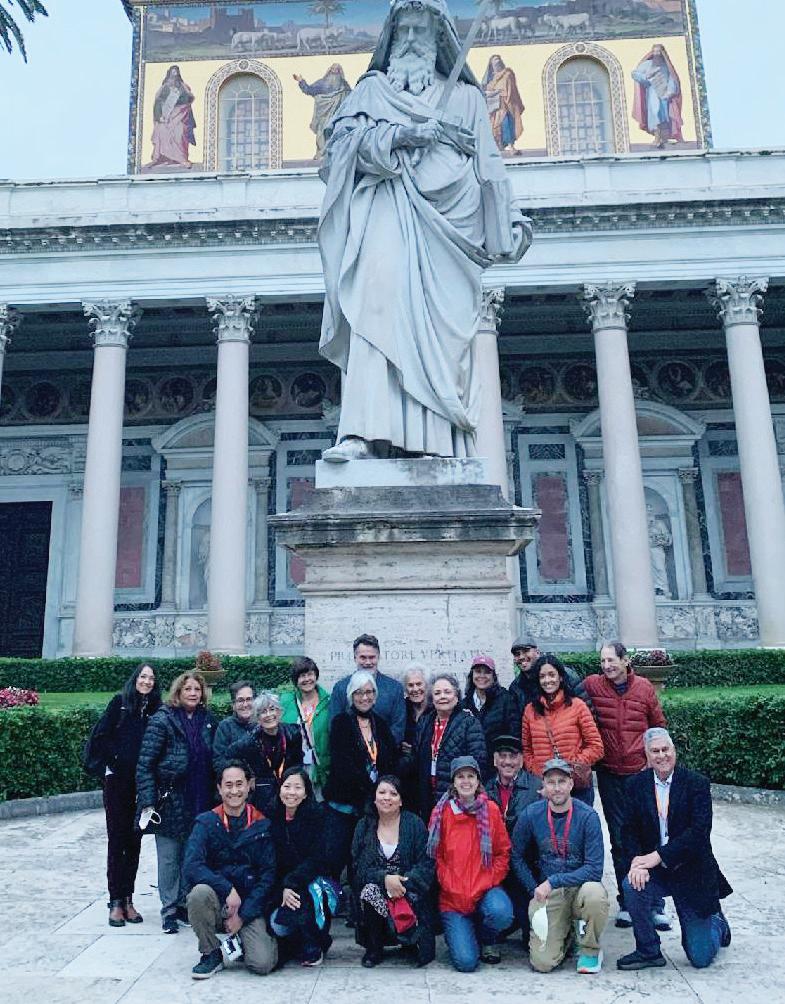
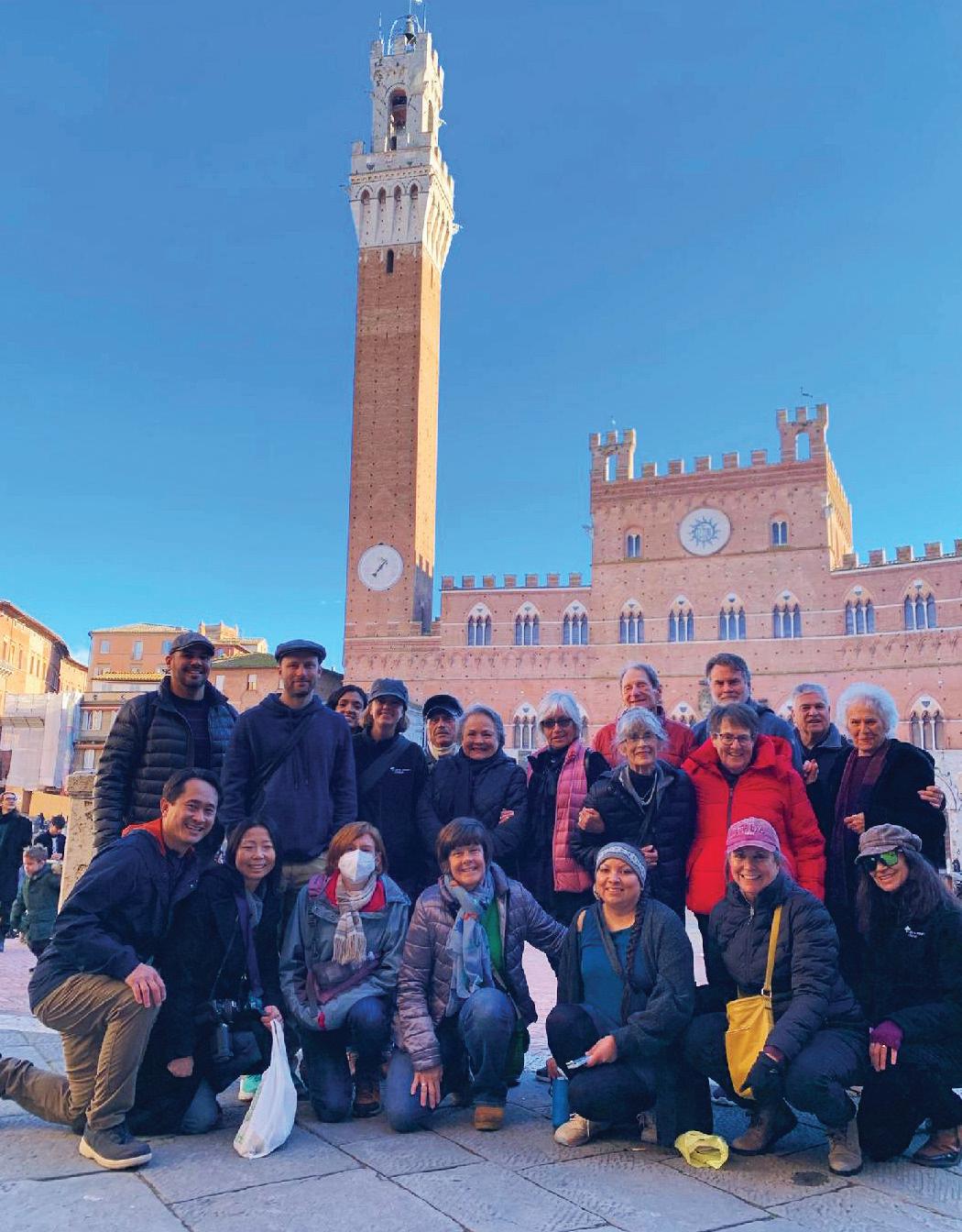
Intercom is the official magazine of the Sisters of Charity of Cincinnati. This apostolic Catholic women’s religious community exists to carry out the Gospel of Jesus Christ through service and prayer in the world. Sisters are joined in their mission by Associates (lay women and men). Sisters, using their professional talents as ministers of education, health care, social services and environmental justice, live and minister in 13 U.S. dioceses. They also sponsor institutions to address education, health care and social service needs, with particular concern for direct service to the poor.
Intercom Staff
Editor
Erin Reder
Graphic Design/Layout
Michelle Bley
Director of Communications
Erin Reder
Executive Council Liaison
S. Barbara Hagedorn
Letters to the editor, articles and photos are welcome. The staff reserves the right to edit for space and readability. Make submissions to: Communications Office 5900 Delhi Road
Mount St. Joseph, OH 45051
Phone: 513-347-5447
Email: erin.reder@srcharitycinti.org
Subscriptions: $15 per year
5900 Delhi Road
Mount Saint Joseph, OH 45051
www.srcharitycinti.org
www.facebook.com/ sisters of charityofcincinnati
VOLUME I, 2024 31
5900 Delhi Road
Mount Saint Joseph, OH 45051
http://www.srcharitycinti.org www.facebook.com/sistersofcharityofcincinnati


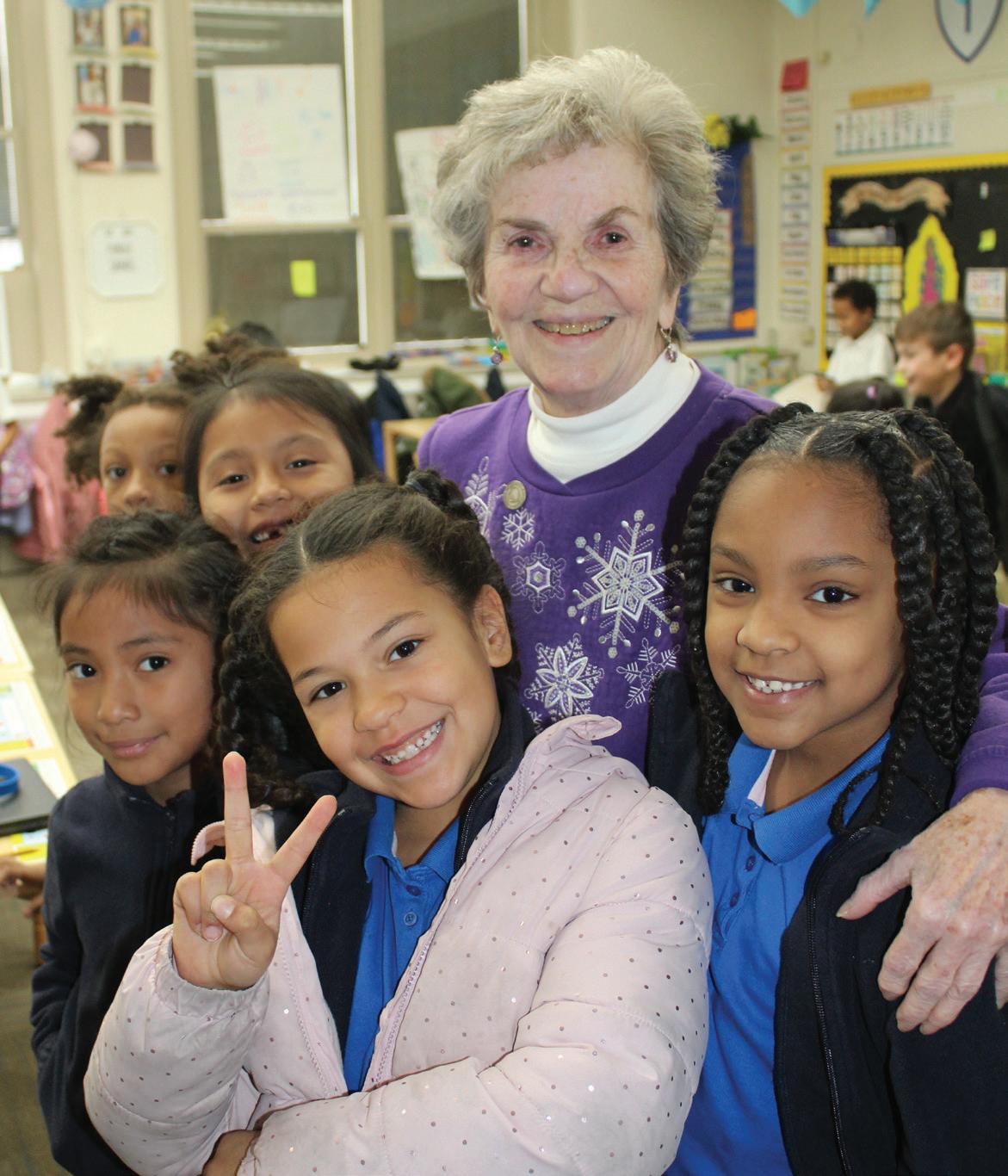
8
17
(Back row, from left) Sisters Carol Wirtz, Andrea Koverman and Peggy Deneweth are committed to serving children and families at the U.S.-Mexico border.
28
Associate Father Bill Morton serves as the pastor of Corpus Christi parish in Juarez, Mexico.
S. Juliette Sabo volunteers as a second grade aide at Romero Academy at Resurrection in Price Hill (Cincinnati).



 Sister Barbara Hagedorn, SC
Sister Barbara Hagedorn, SC








 Sisters from the SC Federation enjoyed the opportunity to connect with each other and others during the January gathering.
(Front row, from left) Sisters Montiel Rosenthal, Pat Dittmeier and (back row, center) Monica Gundler attended the gathering which included Sisters from 108 congregations and 26 different countries.
Sisters from the SC Federation enjoyed the opportunity to connect with each other and others during the January gathering.
(Front row, from left) Sisters Montiel Rosenthal, Pat Dittmeier and (back row, center) Monica Gundler attended the gathering which included Sisters from 108 congregations and 26 different countries.
























































